EXHIBIT 99.2
Published on April 1, 2024
Exhibit 99.2

INNOVATING FOR PATIENTS Nasdaq: TRVN I April 2024
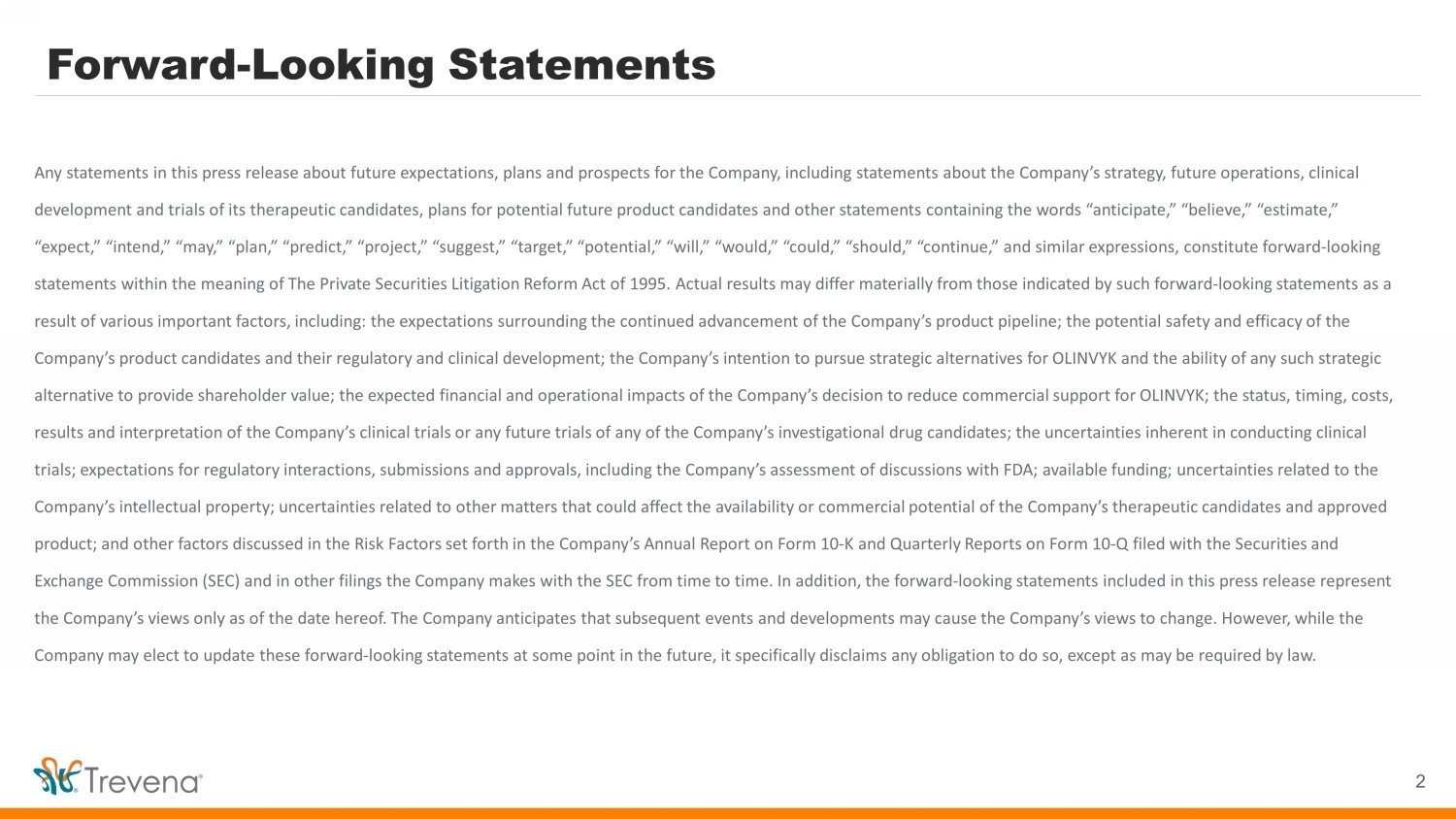
Forward - Looking Statements Any statements in this press release about future expectations, plans and prospects for the Company, including statements abo ut the Company’s strategy, future operations, clinical development and trials of its therapeutic candidates, plans for potential future product candidates and other statements cont ain ing the words “anticipate,” “believe,” “estimate,” “expect,” “intend,” “may,” “plan,” “predict,” “project,” “suggest,” “target,” “potential,” “will,” “would,” “could,” “should, ” “ continue,” and similar expressions, constitute forward - looking statements within the meaning of The Private Securities Litigation Reform Act of 1995. Actual results may differ materially f rom those indicated by such forward - looking statements as a result of various important factors, including: the expectations surrounding the continued advancement of the Company’s product pipeline; the potential safety and efficacy o f t he Company’s product candidates and their regulatory and clinical development; the Company’s intention to pursue strategic alter nat ives for OLINVYK and the ability of any such strategic alternative to provide shareholder value; the expected financial and operational impacts of the Company’s decision to reduce com mercial support for OLINVYK; the status, timing, costs, results and interpretation of the Company’s clinical trials or any future trials of any of the Company’s investigational drug ca ndidates; the uncertainties inherent in conducting clinical trials; expectations for regulatory interactions, submissions and approvals, including the Company’s assessment of discussion s w ith FDA; available funding; uncertainties related to the Company’s intellectual property; uncertainties related to other matters that could affect the availability or commercial pote nti al of the Company’s therapeutic candidates and approved product; and other factors discussed in the Risk Factors set forth in the Company’s Annual Report on Form 10 - K and Quarterly Rep orts on Form 10 - Q filed with the Securities and Exchange Commission (SEC) and in other filings the Company makes with the SEC from time to time. In addition, the forward - lookin g statements included in this press release represent the Company’s views only as of the date hereof. The Company anticipates that subsequent events and developments may cause the Co mpany’s views to change. However, while the Company may elect to update these forward - looking statements at some point in the future, it specifically disclaims any obligati on to do so, except as may be required by law. 2

BOARD OF DIRECTORS Carrie L. Bourdow Jake R. Nunn Scott Braunstein, M.D. Lead Independent Director Anne M. Phillips, M.D. Mark Corrigan, M.D. Barbara Yanni Marvin H. Johnson, Jr. SENIOR MANAGEMENT Carrie L. Bourdow Chair, President & Chief Executive Officer Mark A. Demitrack , M.D . SVP, Chief Medical Officer Patricia Drake SVP, Chief Commercial Officer Barry Shin EVP, Chief Operating Officer and CFO Robert T. Yoder SVP, Chief Business Officer & Head of Commercial Operations Trevena’s Experienced Leadership Team 3
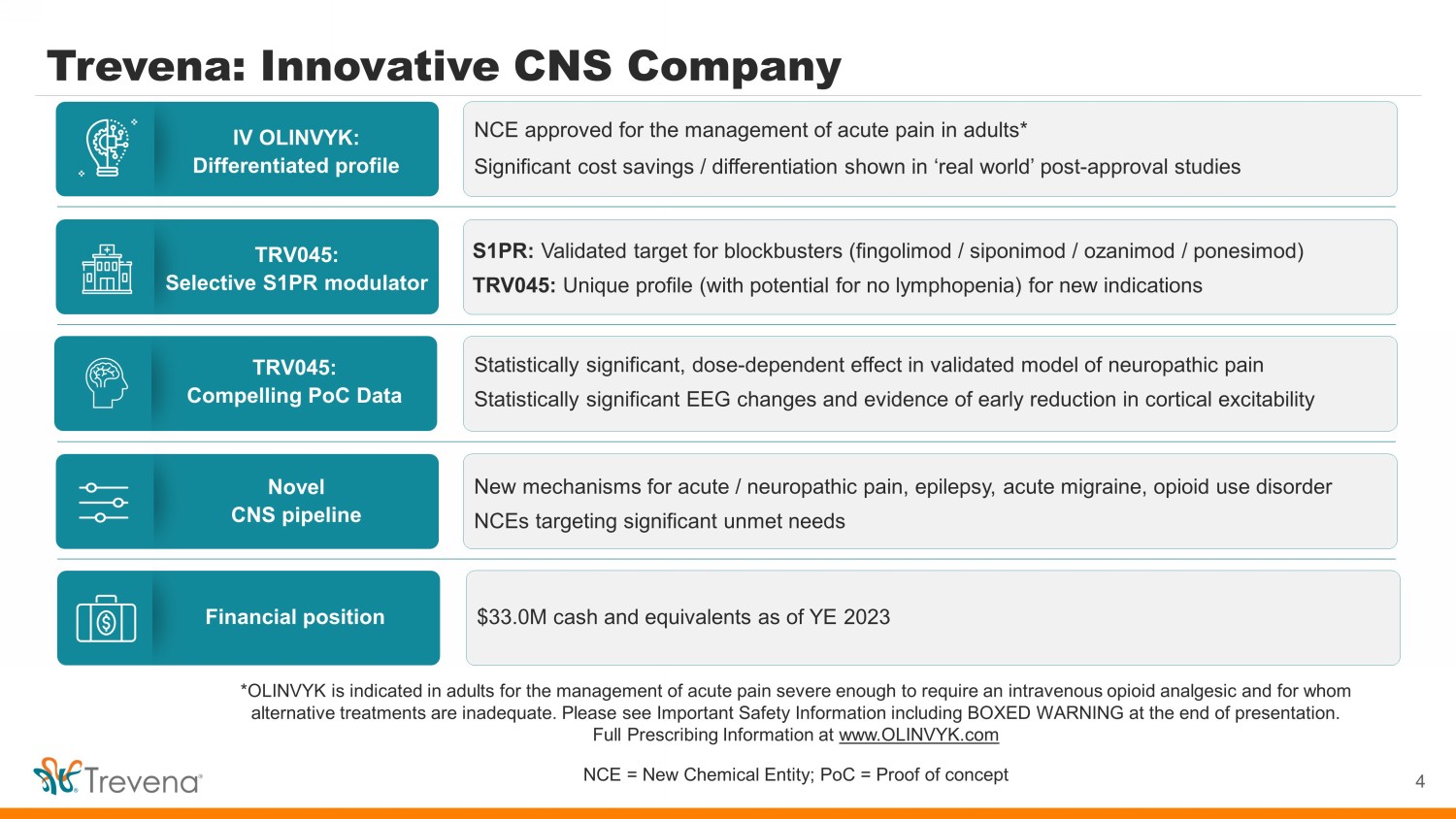
*OLINVYK is indicated in adults for the management of acute pain severe enough to require an intravenous opioid analgesic and fo r whom alternative treatments are inadequate. Please see Important Safety Information including BOXED WARNING at the end of presentation. Full Prescribing Information at www.OLINVYK.com NCE = New Chemical Entity; PoC = Proof of concept Trevena: Innovative CNS Company 4 IV OLINVYK: Differentiated profile TRV045: Selective S1PR modulator Novel CNS pipeline TRV045: Compelling PoC Data Financial position NCE approved for the management of acute pain in adults* Significant cost savings / differentiation shown in ‘real world’ post - approval studies S1PR: Validated target for blockbusters (fingolimod / siponimod / ozanimod / ponesimod ) TRV045: Unique profile (with potential for no lymphopenia) for new indications New mechanisms for acute / neuropathic pain, epilepsy, acute migraine, opioid use disorder NCEs targeting significant unmet needs Statistically significant, dose - dependent effect in validated model of neuropathic pain Statistically significant EEG changes and e vidence of early reduction in cortical excitability $33.0M cash and equivalents as of YE 2023
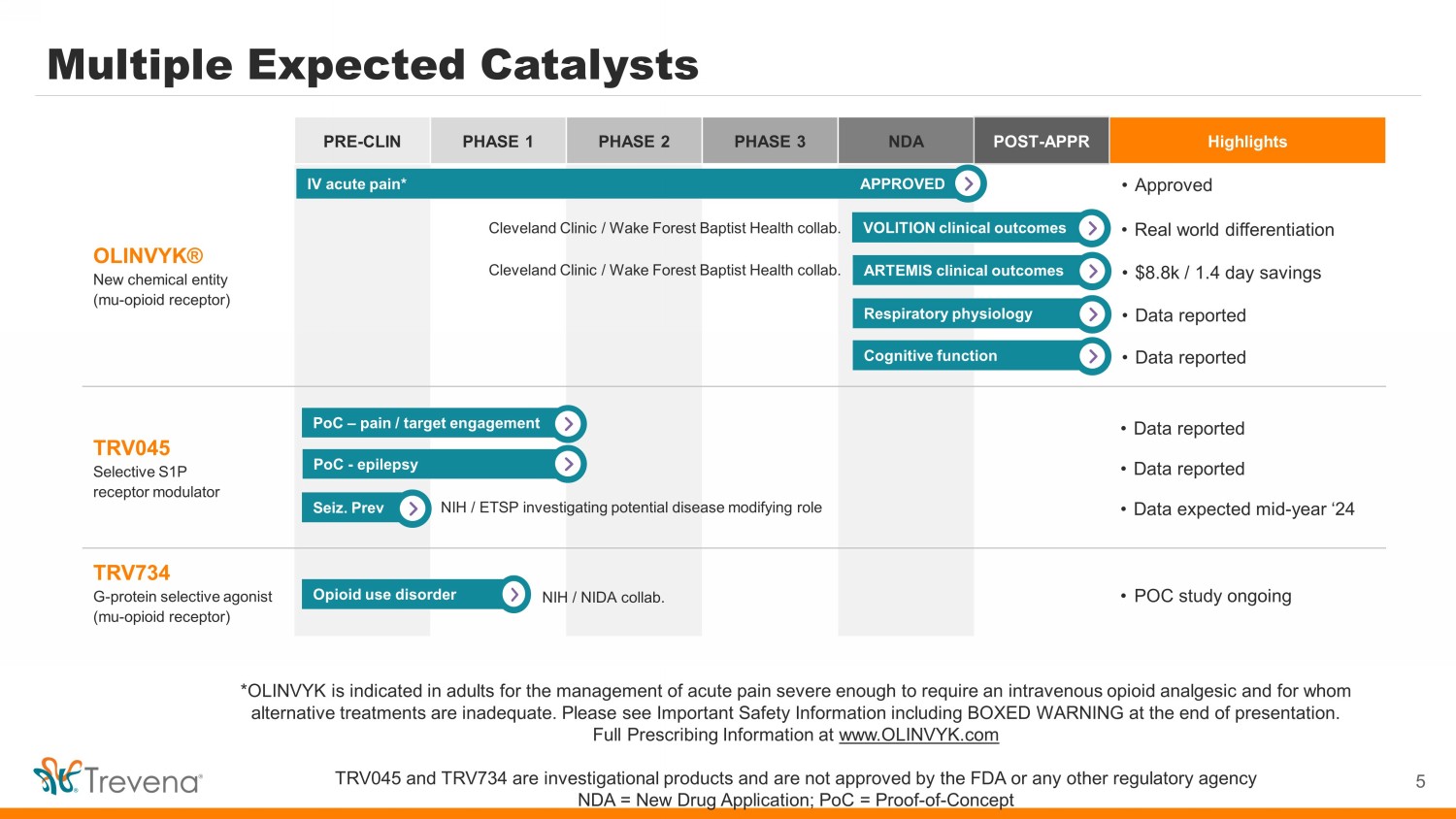
*OLINVYK is indicated in adults for the management of acute pain severe enough to require an intravenous opioid analgesic and fo r whom alternative treatments are inadequate. Please see Important Safety Information including BOXED WARNING at the end of presentation. Full Prescribing Information at www.OLINVYK.com TRV045 and TRV734 are investigational products and are not approved by the FDA or any other regulatory agency NDA = New Drug Application; PoC = Proof - of - Concept PRE - CLIN PHASE 1 PHASE 2 PHASE 3 NDA POST - APPR Highlights OLINVYK® New chemical entity (mu - opioid receptor) TRV045 Selective S1P receptor modulator • Data reported • Data reported • Data expected mid - year ‘24 TRV734 G - protein selective agonist (mu - opioid receptor) Multiple Expected Catalysts 5 NIH / NIDA collab. IV acute pain* VOLITION clinical outcomes Respiratory physiology Cleveland Clinic / Wake Forest Baptist Health collab. PoC – pain / target engagement PoC - epilepsy APPROVED • Real world differentiation • Data reported • Approved • POC study ongoing ARTEMIS clinical outcomes • $8.8k / 1.4 day savings Opioid use disorder Seiz . Prev NIH / ETSP investigating potential disease modifying role Cognitive function Cleveland Clinic / Wake Forest Baptist Health collab. • Data reported

OLINVYK Overview
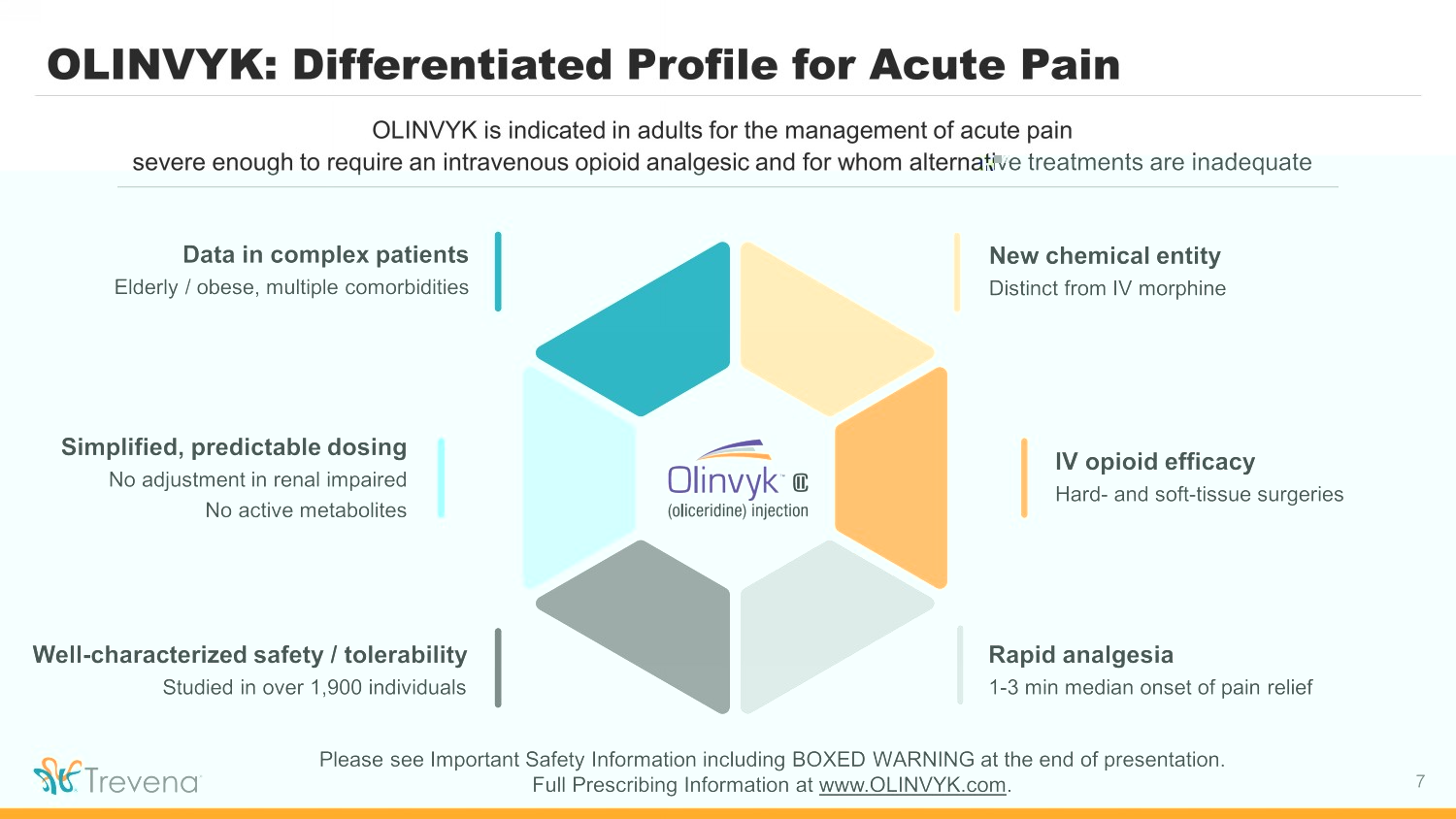
OLINVYK: Differentiated Profile for Acute Pain 7 OLINVYK is indicated in adults for the management of acute pain severe enough to require an intravenous opioid analgesic and for whom alternative treatments are inadequate Please see Important Safety Information including BOXED WARNING at the end of presentation. Full Prescribing Information at www.OLINVYK.com . New chemical entity Distinct from IV morphine IV opioid efficacy Hard - and soft - tissue surgeries Rapid analgesia 1 - 3 min median onset of pain relief Simplified, predictable dosing No adjustment in renal impaired No active metabolites Data in complex patients Elderly / obese, multiple comorbidities Well - characterized safety / tolerability Studied in over 1,900 individuals
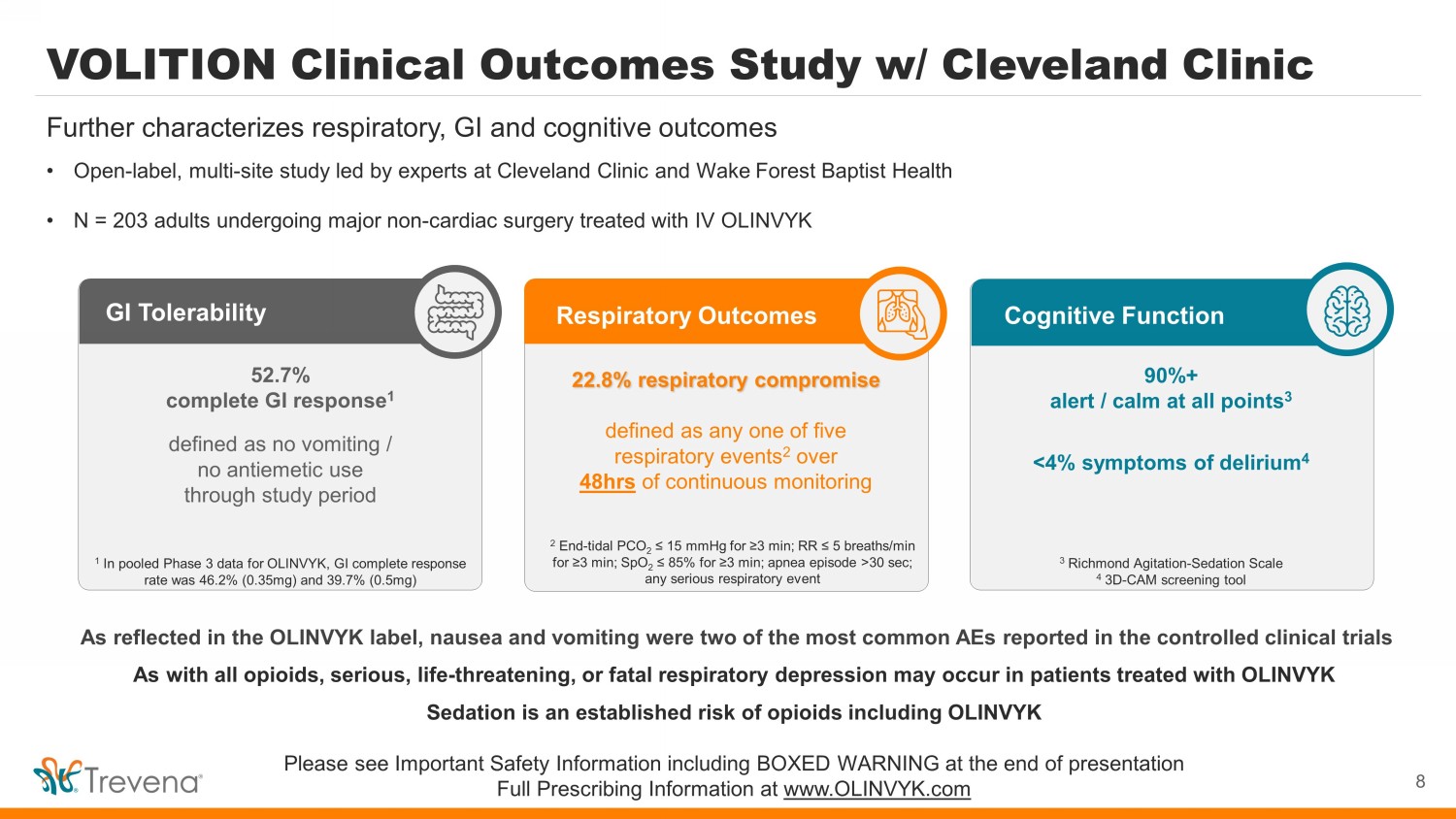
VOLITION Clinical Outcomes Study w/ Cleveland Clinic • Open - label, multi - site study led by experts at Cleveland Clinic and Wake Forest Baptist Health • N = 203 adults undergoing major non - cardiac surgery treated with IV OLINVYK Further characterizes respiratory, GI and cognitive outcomes Cognitive Function 90%+ alert / calm at all points 3 <4% symptoms of delirium 4 3 Richmond Agitation - Sedation Scale 4 3D - CAM screening tool As reflected in the OLINVYK label, nausea and vomiting were two of the most common AEs reported in the controlled clinical tr ia ls As with all opioids, serious, life - threatening, or fatal respiratory depression may occur in patients treated with OLINVYK Sedation is an established risk of opioids including OLINVYK Please see Important Safety Information including BOXED WARNING at the end of presentation Full Prescribing Information at www.OLINVYK.com GI Tolerability 52.7% complete GI response 1 defined as no vomiting / no antiemetic use through study period 1 In pooled Phase 3 data for OLINVYK, GI complete response rate was 46.2% (0.35mg) and 39.7% (0.5mg) Respiratory Outcomes 22.8% respiratory compromise defined as any one of five respiratory events 2 over 48hrs of continuous monitoring 2 End - tidal PCO 2 ≤ 15 mmHg for ≥3 min; RR ≤ 5 breaths/min for ≥3 min; SpO 2 ≤ 85% for ≥3 min; a pnea episode >30 sec; any serious respiratory event 8
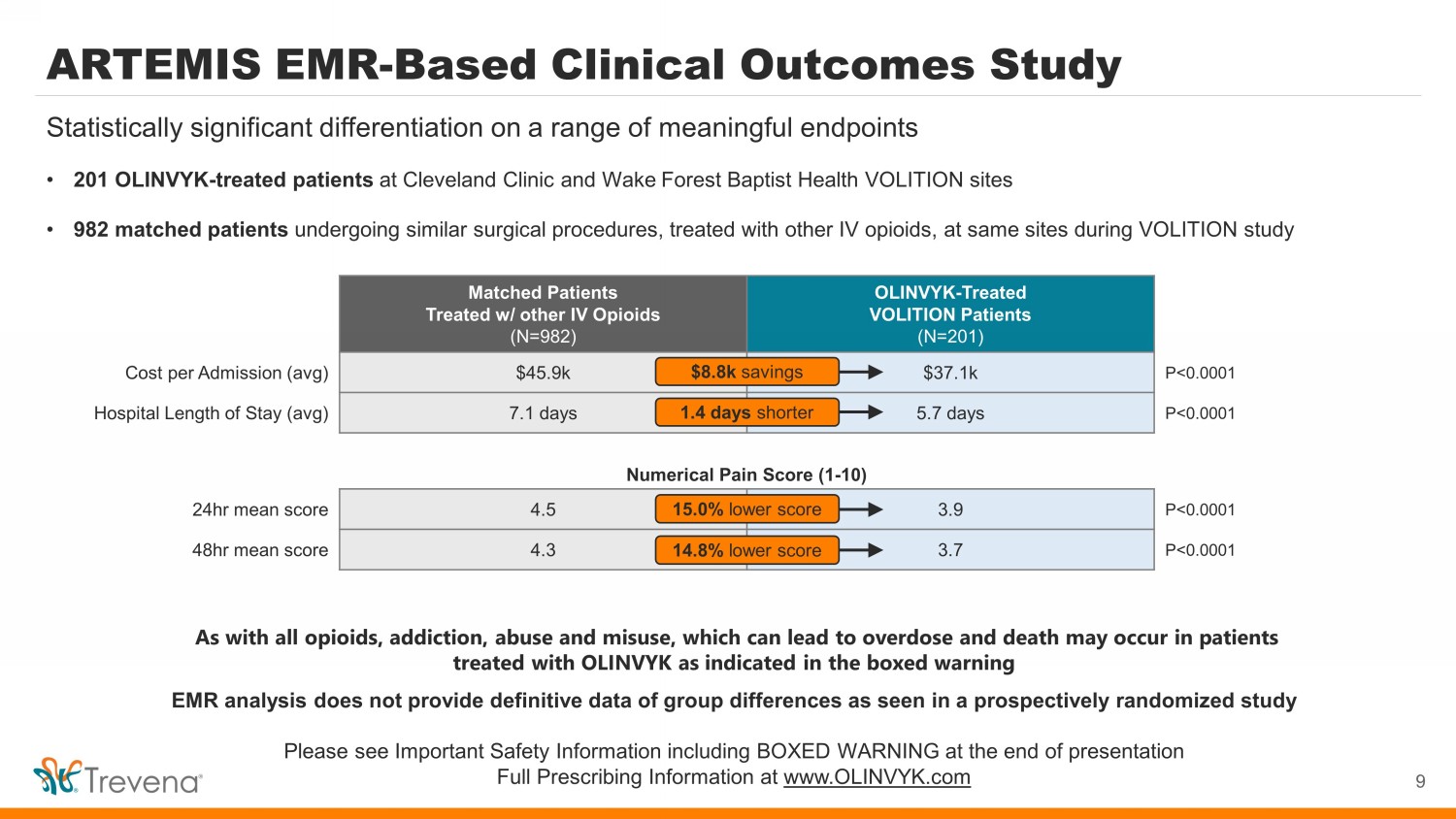
ARTEMIS EMR - Based Clinical Outcomes Study • 201 OLINVYK - treated patients at Cleveland Clinic and Wake Forest Baptist Health VOLITION sites • 982 matched patients undergoing similar surgical procedures, treated with other IV opioids, at same sites during VOLITION study 9 Statistically significant differentiation on a range of meaningful endpoints Matched Patients Treated w/ other IV Opioids (N=982) OLINVYK - Treated VOLITION Patients (N=201) Cost per Admission (avg) $45.9k $37.1k P<0.0001 Hospital Length of Stay (avg) 7.1 days 5.7 days P<0.0001 $8.8k savings 1.4 days shorter 24hr mean score 4.5 3.9 P<0.0001 48hr mean score 4.3 3.7 P<0.0001 15.0% lower score 14.8% lower score Numerical Pain Score (1 - 10) As with all opioids, addiction, abuse and misuse, which can lead to overdose and death may occur in patients treated with OLINVYK as indicated in the boxed warning EMR analysis does not provide definitive data of group differences as seen in a prospectively randomized study Please see Important Safety Information including BOXED WARNING at the end of presentation Full Prescribing Information at www.OLINVYK.com
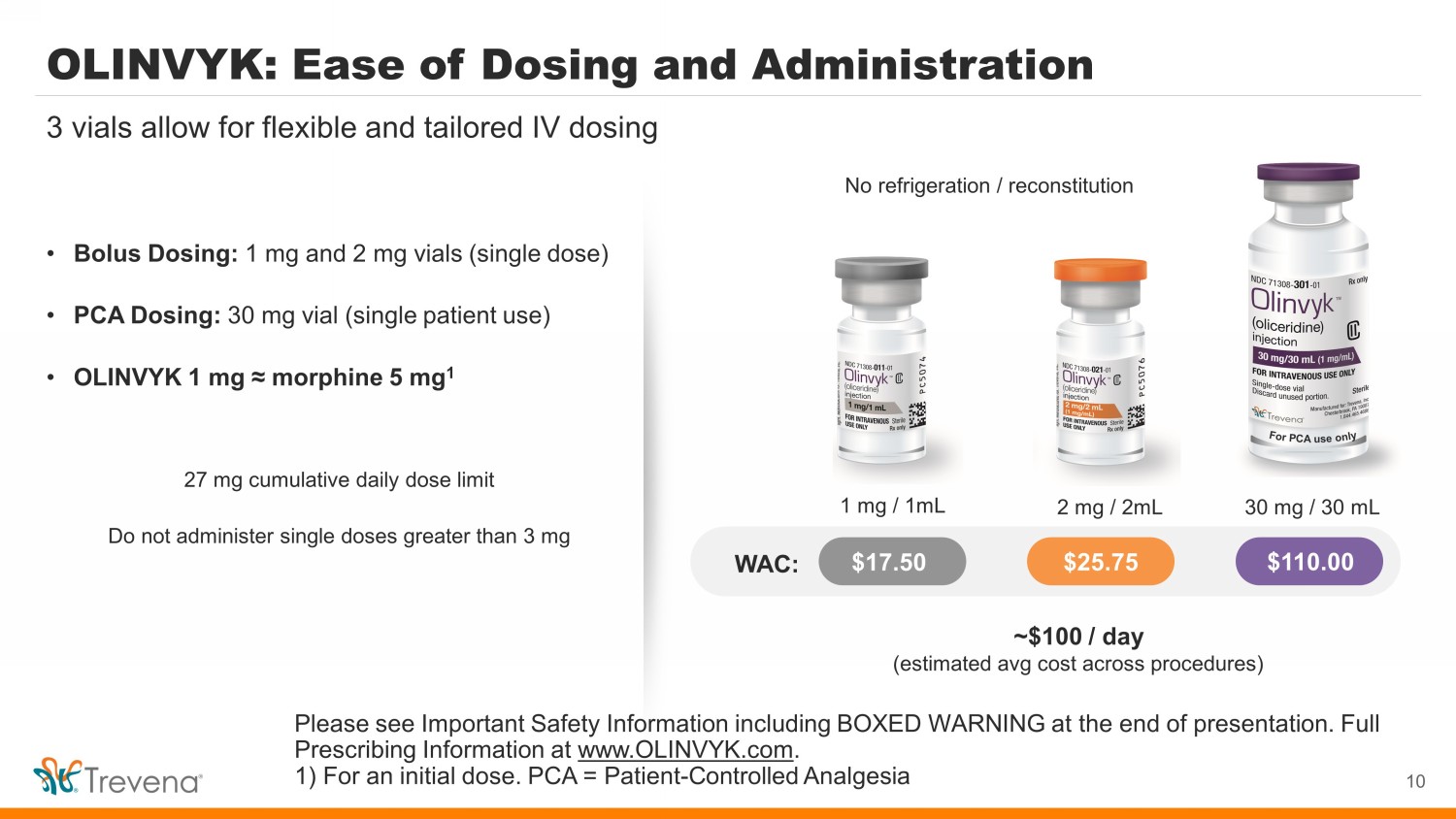
OLINVYK: Ease of Dosing and Administration • Bolus Dosing: 1 mg and 2 mg vials (single dose) • PCA Dosing: 30 mg vial (single patient use) • OLINVYK 1 mg ≈ morphine 5 mg 1 27 mg cumulative daily dose limit Do not administer single doses greater than 3 mg 10 3 vials allow for flexible and tailored IV dosing No refrigeration / reconstitution $17.50 $25.75 $110.00 WAC: 1 mg / 1mL 30 mg / 30 mL 2 mg / 2mL ~$100 / day (estimated avg cost across procedures) Please see Important Safety Information including BOXED WARNING at the end of presentation. Full Prescribing Information at www.OLINVYK.com . 1) For an initial dose. PCA = Patient - Controlled Analgesia

TRV045 Overview
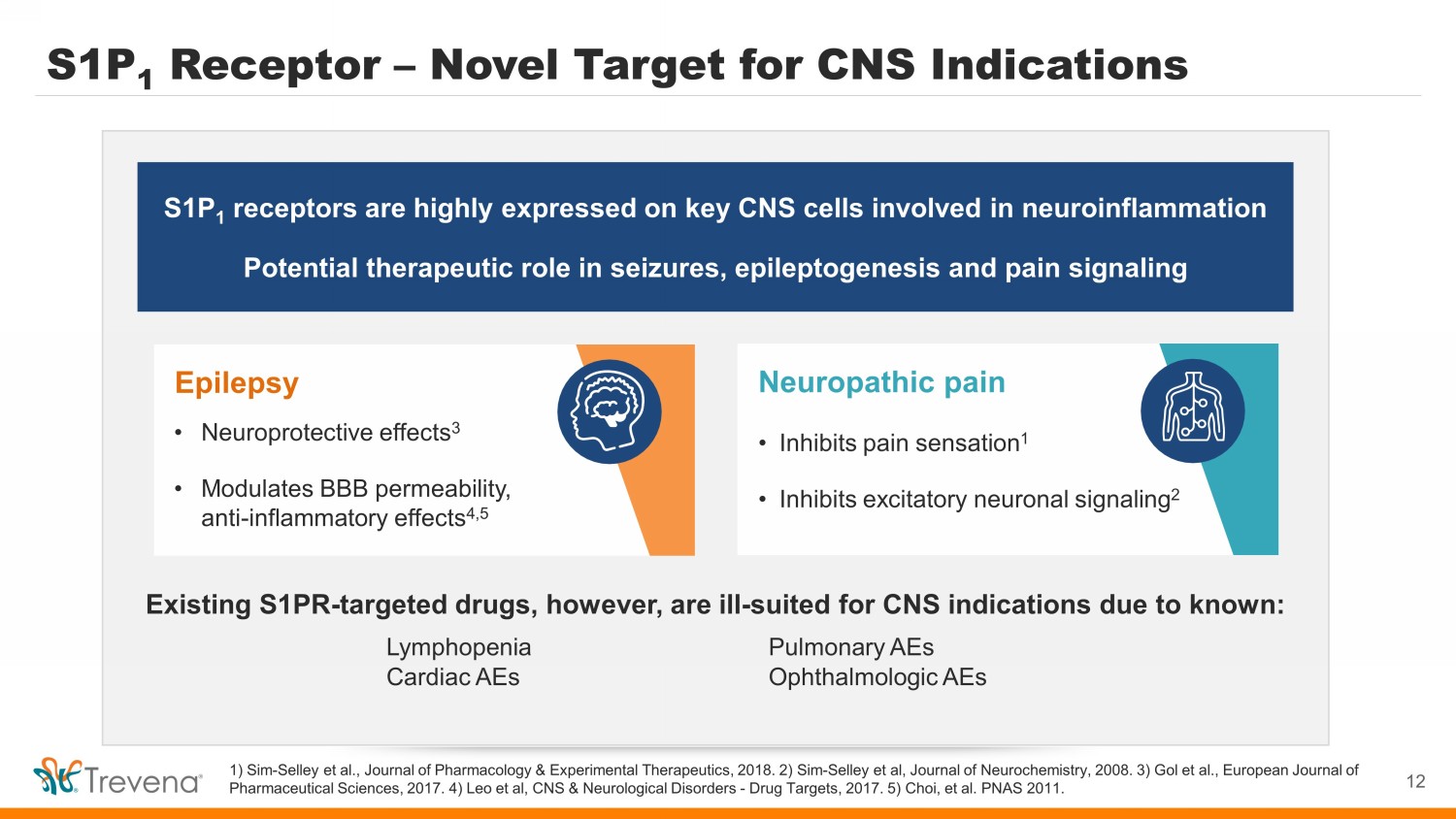
S1P 1 Receptor – Novel Target for CNS Indications 1) Sim - Selley et al., Journal of Pharmacology & Experimental Therapeutics, 2018. 2) Sim - Selley et al, Journal of Neurochemistry, 2008. 3) Gol et al., European Journal of Pharmaceutical Sciences, 2017. 4) Leo et al, CNS & Neurological Disorders - Drug Targets, 2017. 5) Choi, et al. PNAS 2011. S1P 1 receptors are highly expressed on key CNS cells involved in neuroinflammation Potential therapeutic role in seizures, epileptogenesis and pain signaling Neuropathic pain • Inhibits pain sensation 1 • Inhibits excitatory neuronal signaling 2 Existing S1PR - targeted drugs, however, are ill - suited for CNS indications due to known: Lymphopenia Pulmonary AEs Cardiac AEs Ophthalmologic AEs Epilepsy • Neuroprotective effects 3 • Modulates BBB permeability, anti - inflammatory effects 4,5 12
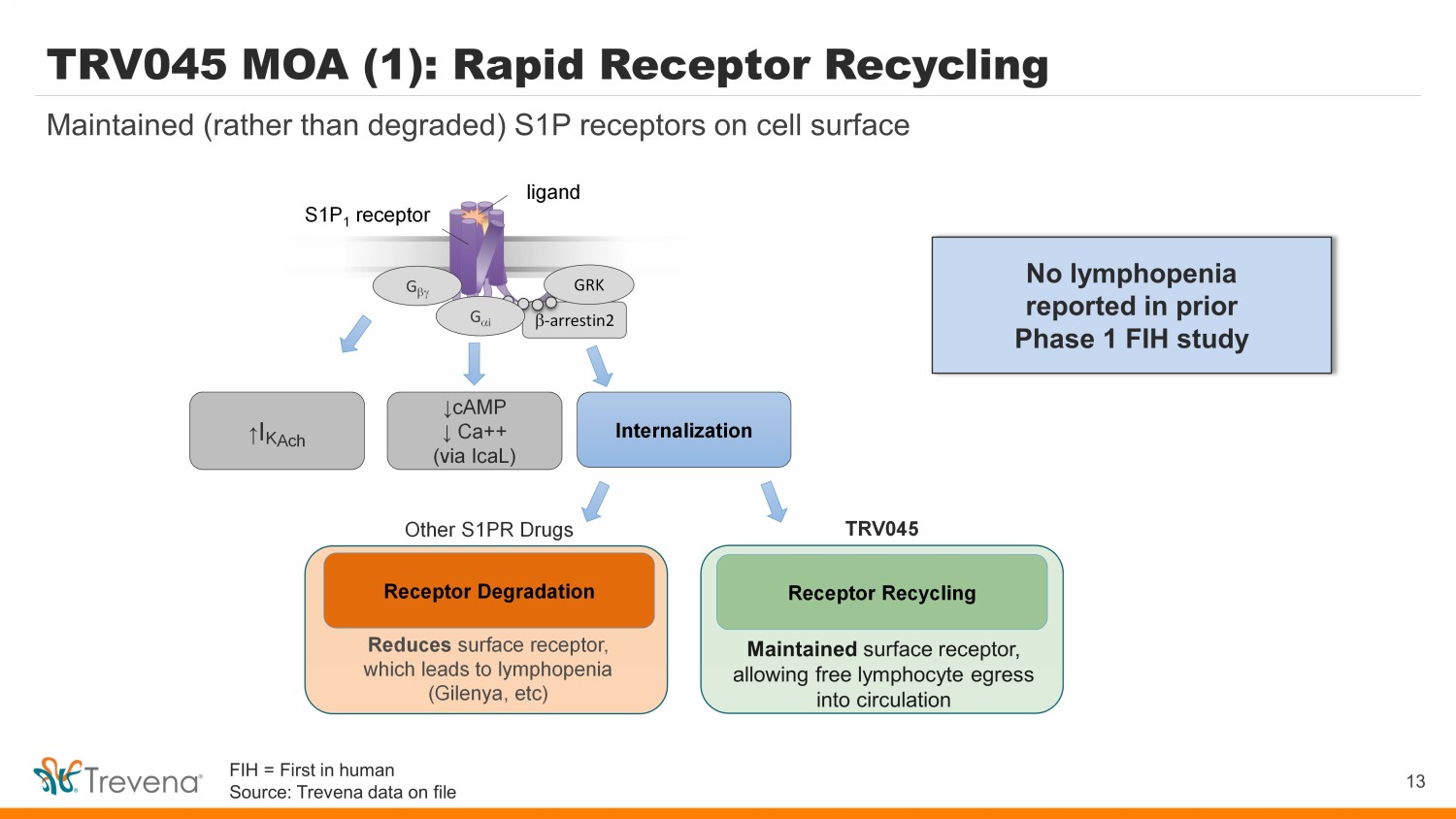
TRV045 MOA (1): Rapid Receptor Recycling b - arrestin2 S1P 1 receptor G GRK Internalization ↑ I K Ach ligand G a i ↓cAMP ↓ Ca++ (via IcaL ) Reduces surface receptor, which leads to lymphopenia ( Gilenya , etc ) Receptor R ecycling Maintains surface receptor and avoids lymphopenia, allowing free lymphocyte egress into circulation Receptor Degradation Other S1PR Drugs TRV045 13 Maintained (rather than degraded) S1P receptors on cell surface No lymphopenia reported in prior Phase 1 FIH study Maintained surface receptor, allowing free lymphocyte egress into circulation FIH = First in human Source: Trevena data on file
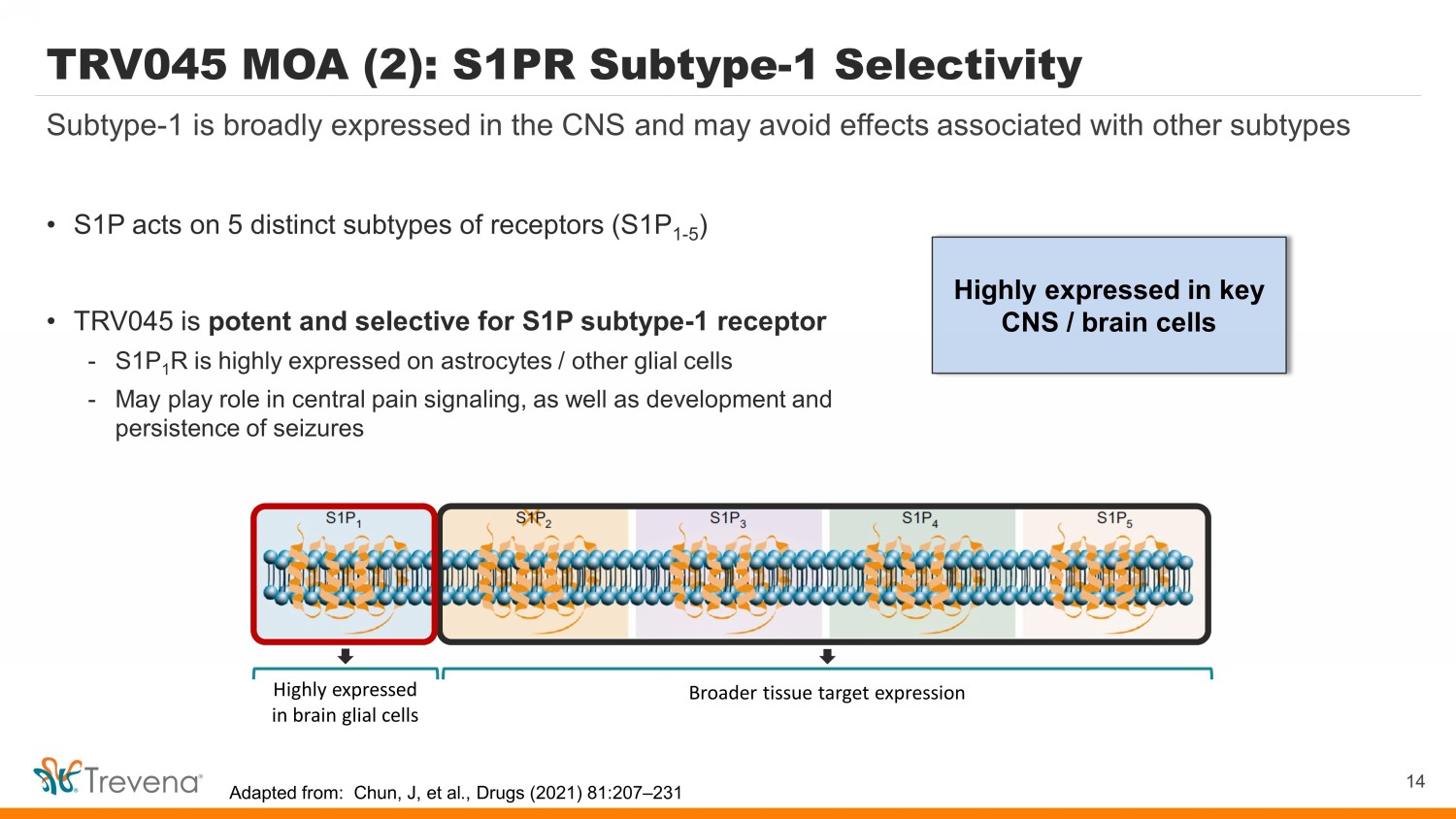
Highly expressed in key CNS / brain cells TRV045 MOA (2): S1PR Subtype - 1 Selectivity • S1P acts on 5 distinct subtypes of receptors (S1P 1 - 5 ) • TRV045 is potent and selective for S1P subtype - 1 receptor - S1P 1 R is highly expressed on astrocytes / other glial cells - May play role in central pain signaling, as well as development and persistence of seizures 14 Subtype - 1 is broadly expressed in the CNS and may avoid effects associated with other subtypes Highly expressed in brain glial cells Broader tissue target expression Adapted from: Chun, J, et al., Drugs (2021) 81:207 – 231
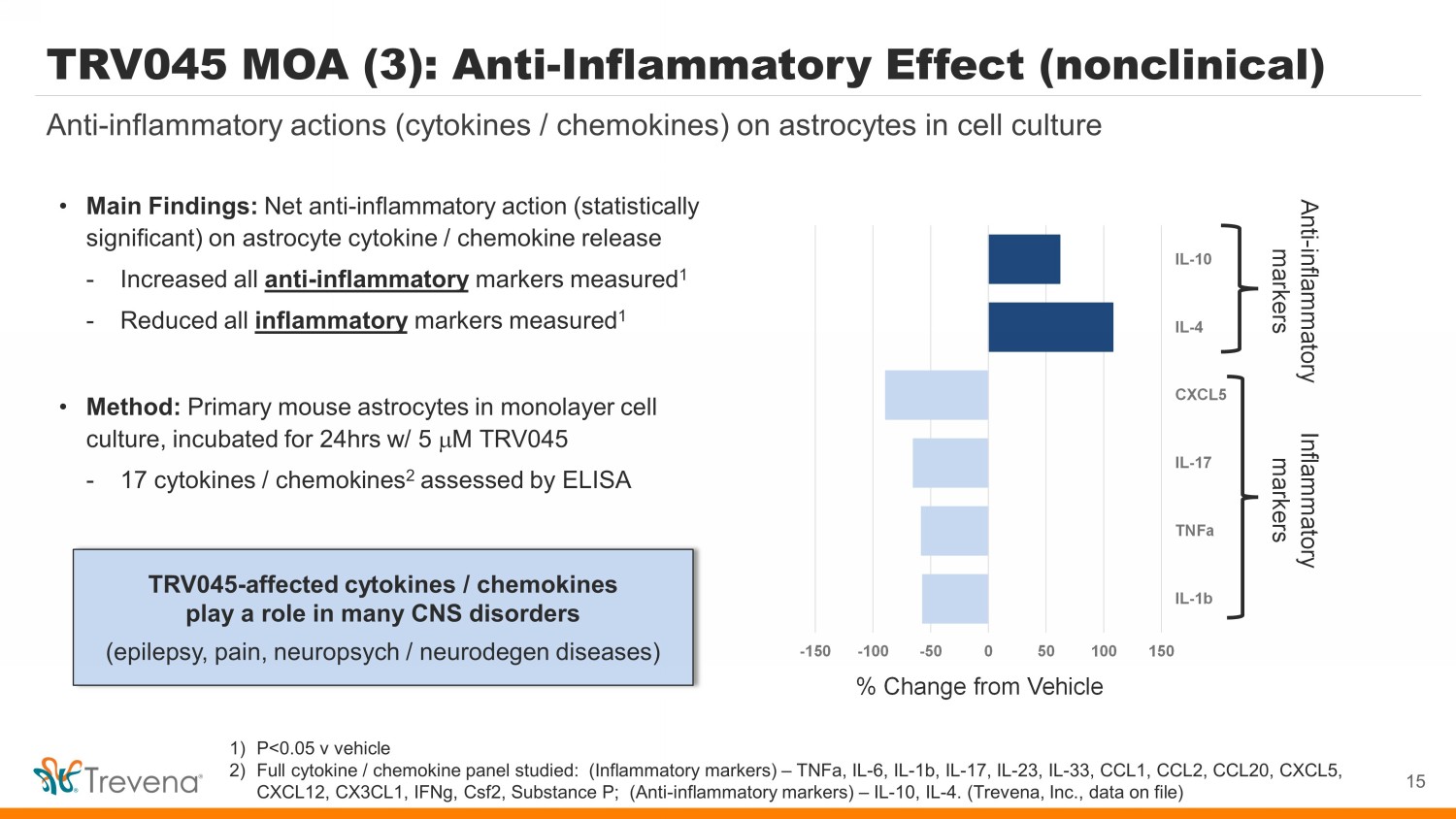
1) P<0.05 v vehicle 2) Full cytokine / chemokine panel studied: (Inflammatory markers) – TNFa , IL - 6, IL - 1b, IL - 17, IL - 23, IL - 33, CCL1, CCL2, CCL20, CXCL5, CXCL12, CX3CL1, IFNg , Csf2, Substance P; (Anti - inflammatory markers) – IL - 10, IL - 4. (Trevena, Inc., data on file) TRV045 MOA (3): Anti - Inflammatory Effect (nonclinical) • Main Findings: Net anti - inflammatory action (statistically significant) on astrocyte cytokine / chemokine release - Increased all anti - inflammatory markers measured 1 - Reduced all inflammatory markers measured 1 • Method: Primary mouse astrocytes in monolayer cell culture, incubated for 24hrs w/ 5 m M TRV045 - 17 cytokines / chemokines 2 assessed by ELISA TRV045 - affected cytokines / chemokines play a role in many CNS disorders (epilepsy, pain, neuropsych / neurodegen diseases) Anti - inflammatory actions (cytokines / chemokines) on astrocytes in cell culture 15 -150 -100 -50 0 50 100 150 IL-1b TNFa IL-17 CXCL5 IL-4 IL-10 % Change from Vehicle Anti - inflammatory markers Inflammatory markers
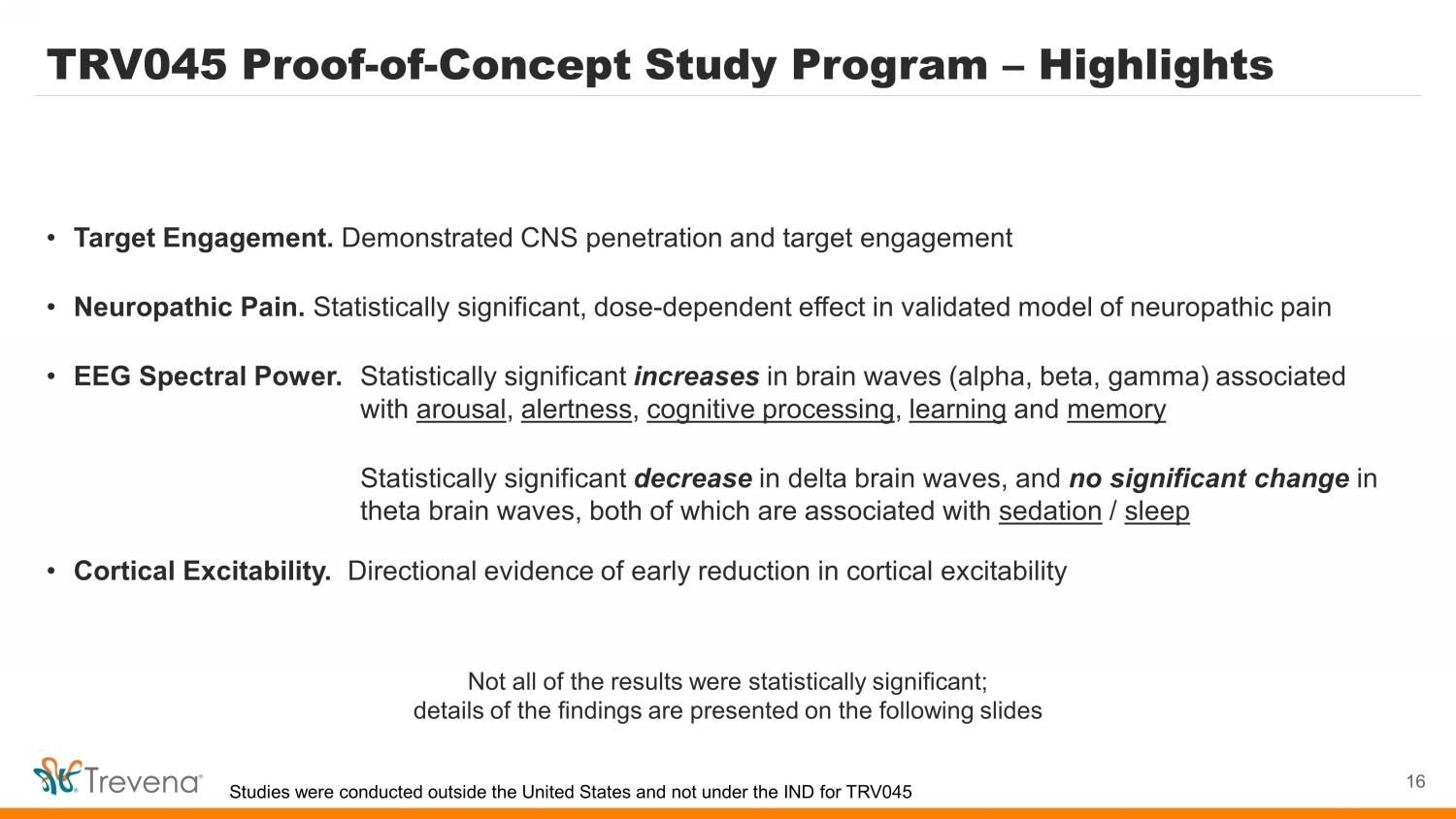
TRV045 Proof - of - Concept Study Program – Highlights • Target Engagement. Demonstrated CNS penetration and target engagement • Neuropathic Pain. Statistically significant, dose - dependent effect in validated model of neuropathic pain • EEG Spectral Power. Statistically significant increases in brain waves (alpha, beta, gamma) associated with arousal , alertness , cognitive processing , learning and memory Statistically significant decrease in delta brain waves, and no significant change in theta brain waves, both of which are associated with sedation / sleep • Cortical Excitability. Directional evidence of early reduction in cortical excitability Not all of the results were statistically significant; details of the findings are presented on the following slides Studies were conducted outside the United States and not under the IND for TRV045 16
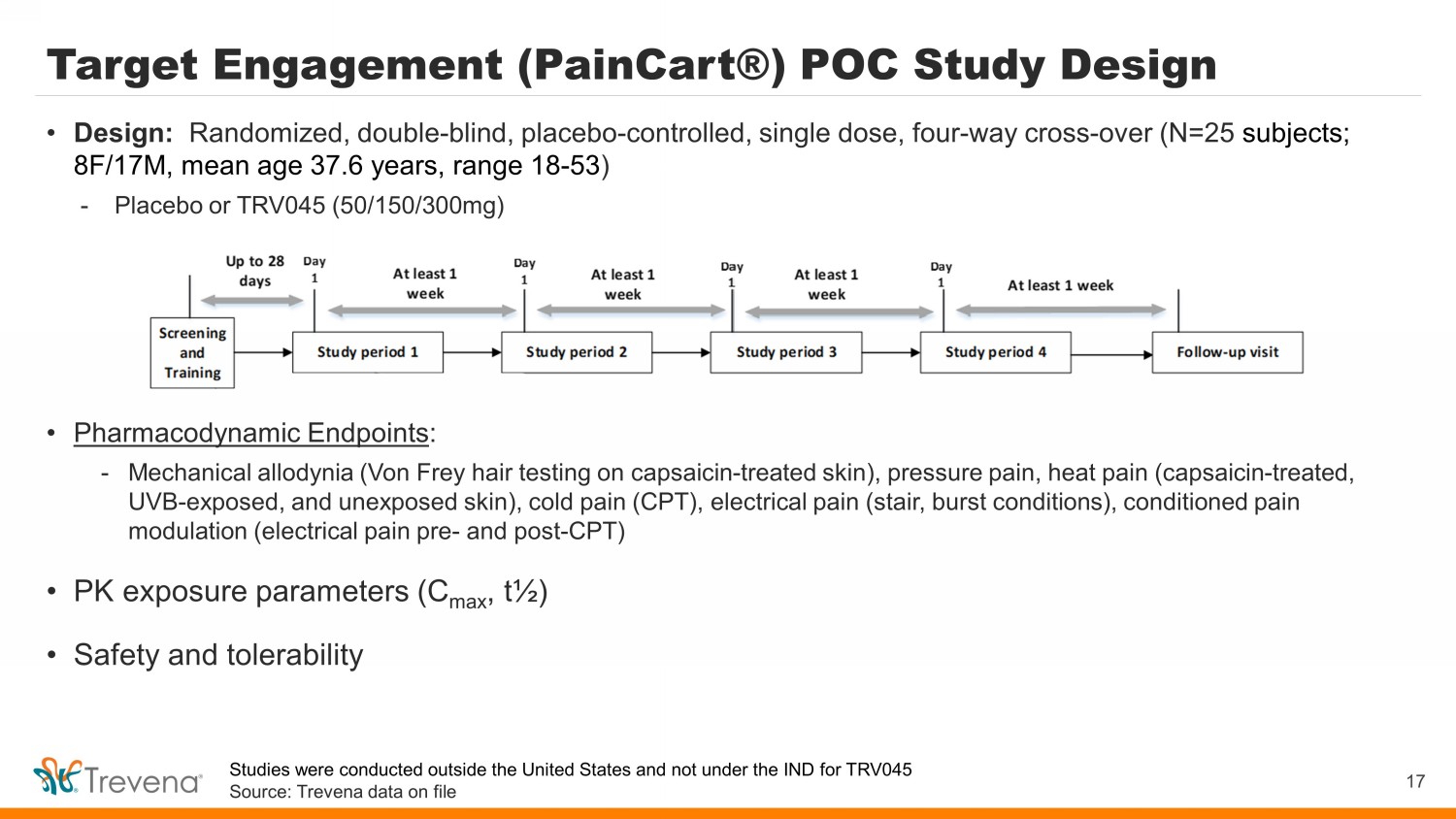
Target Engagement ( PainCart ®) POC Study Design • Pharmacodynamic Endpoints : - Mechanical allodynia (Von Frey hair testing on capsaicin - treated skin), pressure pain, heat pain (capsaicin - treated, UVB - exposed, and unexposed skin), cold pain (CPT), electrical pain (stair, burst conditions), conditioned pain modulation (electrical pain pre - and post - CPT) • PK exposure parameters ( C max , t½) • Safety and tolerability 17 • Design: Randomized, double - blind, placebo - controlled, single dose, four - way cross - over (N=25 subjects; 8F/17M, mean age 37.6 years, range 18 - 53 ) - Placebo or TRV045 (50/150/300mg) Studies were conducted outside the United States and not under the IND for TRV045 Source: Trevena data on file
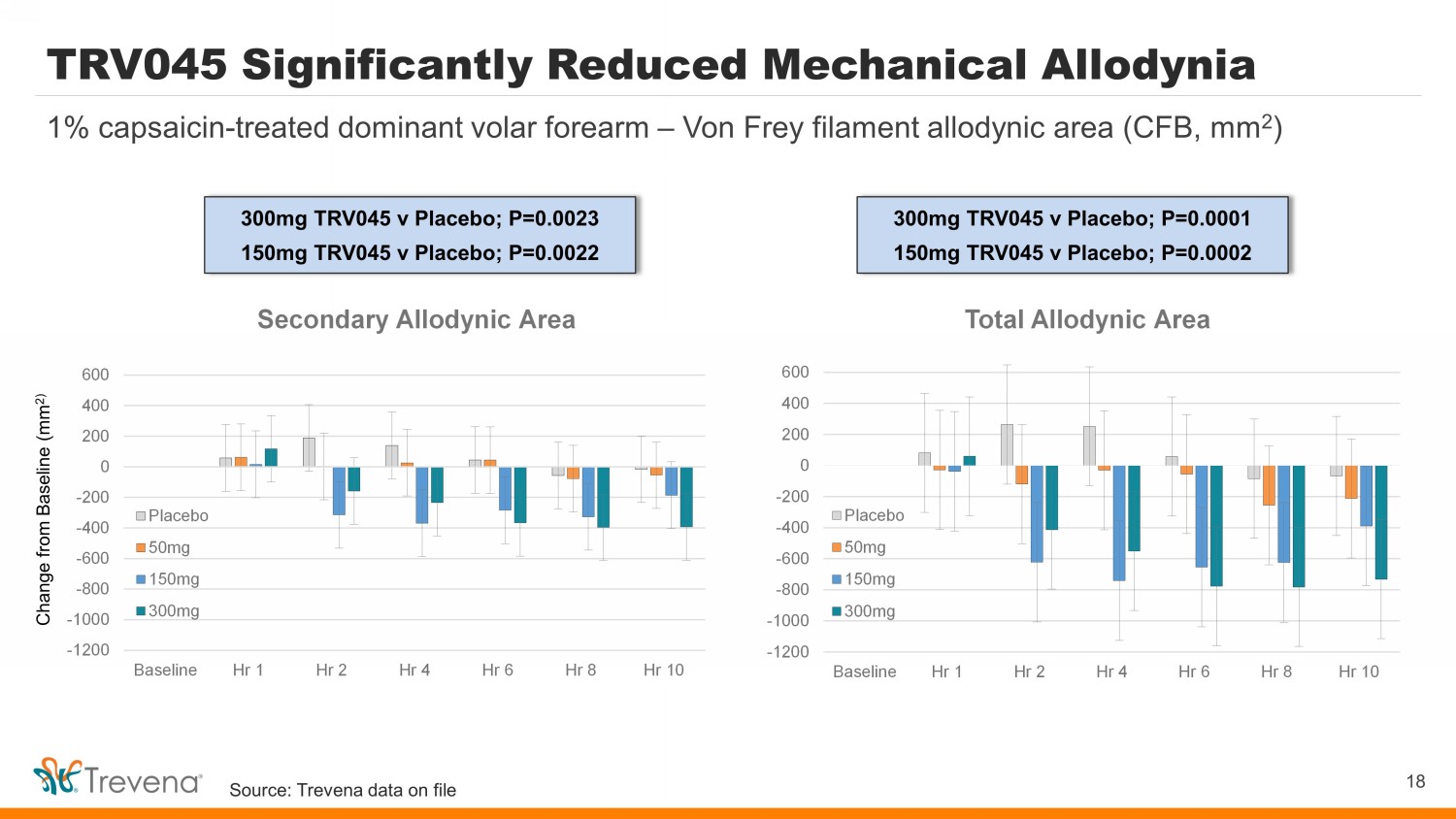
TRV045 Significantly Reduced Mechanical Allodynia 18 1% capsaicin - treated dominant volar forearm – Von Frey filament allodynic area (CFB, mm 2 ) Change from Baseline (mm 2) -1200 -1000 -800 -600 -400 -200 0 200 400 600 Baseline Hr 1 Hr 2 Hr 4 Hr 6 Hr 8 Hr 10 Total Allodynic Area Placebo 50mg 150mg 300mg -1200 -1000 -800 -600 -400 -200 0 200 400 600 Baseline Hr 1 Hr 2 Hr 4 Hr 6 Hr 8 Hr 10 Secondary Allodynic Area Placebo 50mg 150mg 300mg 300mg TRV045 v Placebo; P=0.0023 150mg TRV045 v Placebo; P=0.0022 300mg TRV045 v Placebo; P=0.0001 150mg TRV045 v Placebo; P=0.0002 Source: Trevena data on file
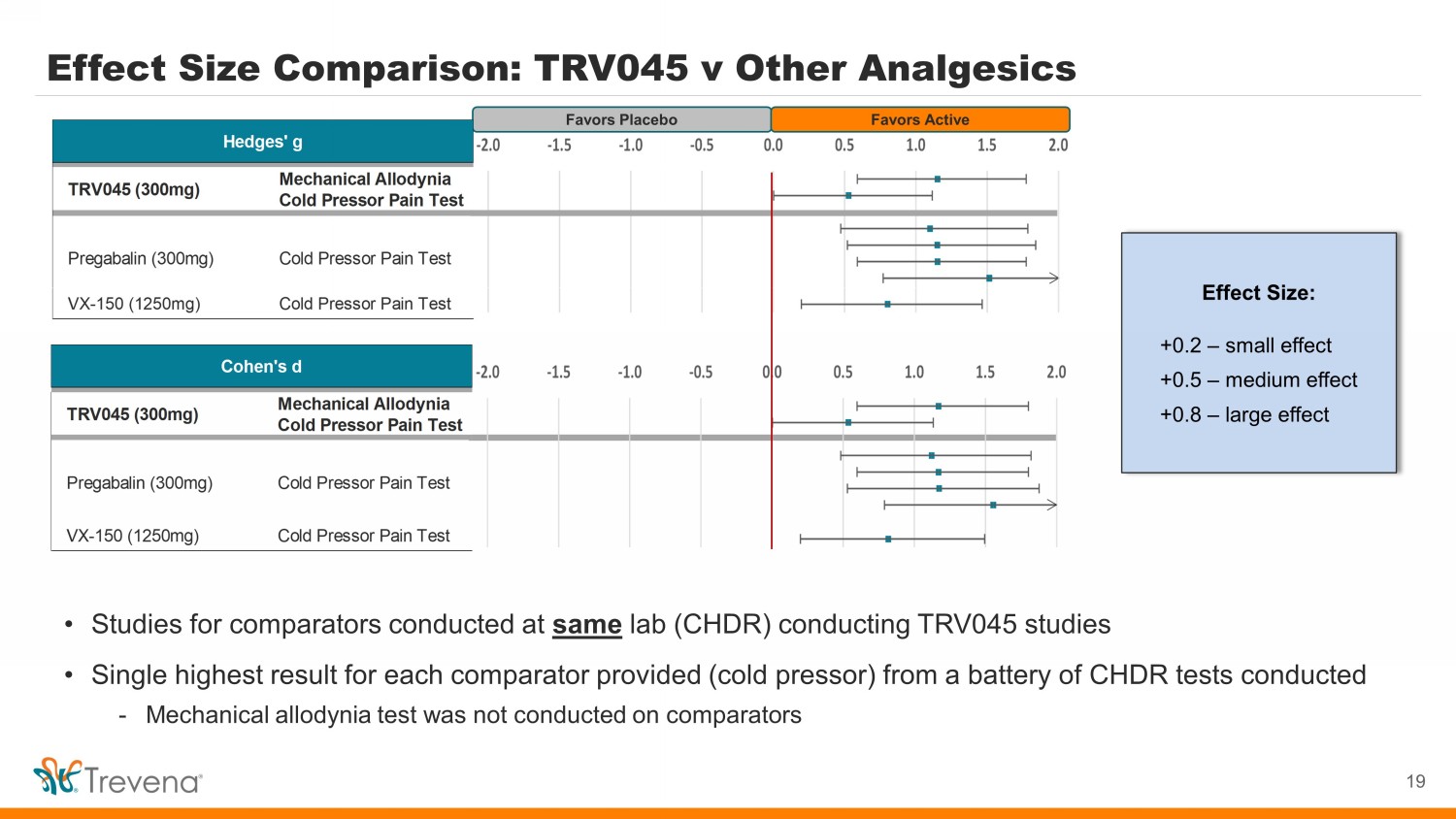
Effect Size Comparison: TRV045 v Other Analgesics 19 Favors Placebo Favors Active • Studies for comparators conducted at same lab (CHDR) conducting TRV045 studies • Single highest result for each comparator provided (cold pressor) from a battery of CHDR tests conducted - Mechanical allodynia test was not conducted on comparators Effect Size: +0.2 – small effect +0.5 – medium effect +0.8 – large effect
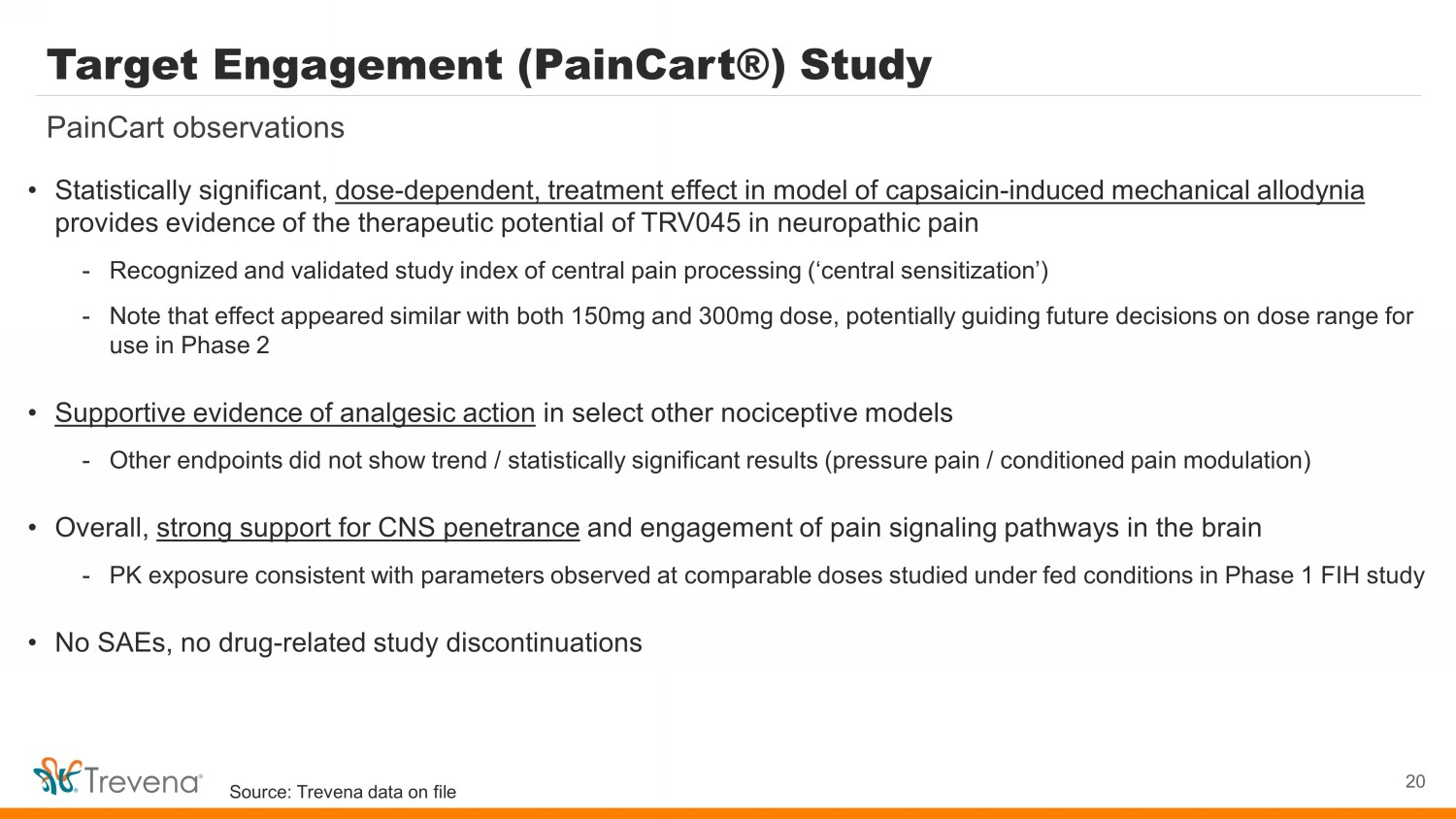
Source: Trevena data on file Target Engagement ( PainCart ®) Study • Statistically significant, dose - dependent, treatment effect in model of capsaicin - induced mechanical allodynia provides evidence of the therapeutic potential of TRV045 in neuropathic pain - Recognized and validated study index of central pain processing (‘central sensitization’) - Note that effect appeared similar with both 150mg and 300mg dose, potentially guiding future decisions on dose range for use in Phase 2 • Supportive evidence of analgesic action in select other nociceptive models - Other endpoints did not show trend / statistically significant results (pressure pain / conditioned pain modulation) • Overall, strong support for CNS penetrance and engagement of pain signaling pathways in the brain - PK exposure consistent with parameters observed at comparable doses studied under fed conditions in Phase 1 FIH study • No SAEs, no drug - related study discontinuations 20 PainCart observations
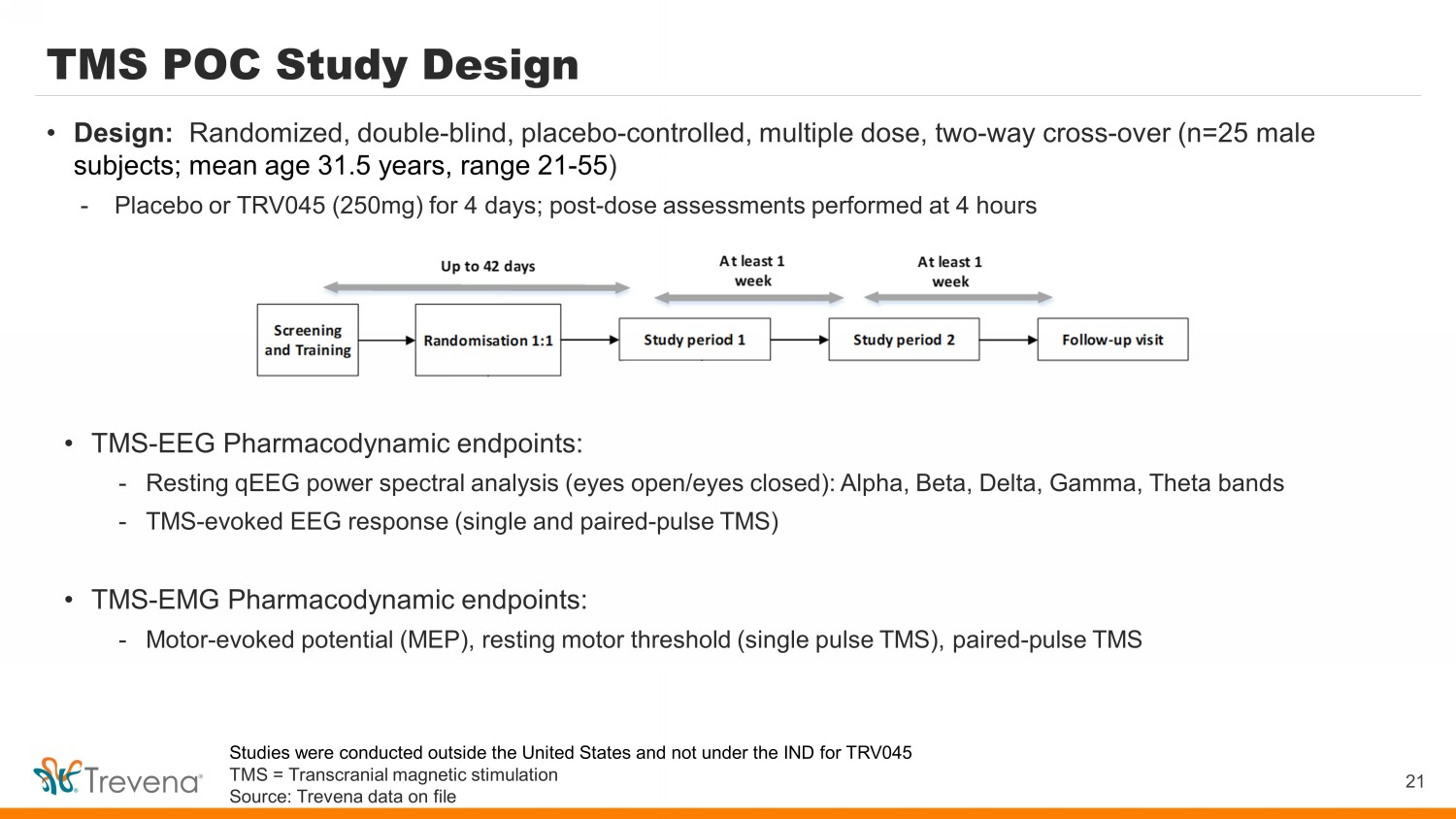
TMS POC Study Design • TMS - EEG Pharmacodynamic endpoints: - Resting qEEG power spectral analysis (eyes open/eyes closed): Alpha, Beta, Delta, Gamma, Theta bands - TMS - evoked EEG response (single and paired - pulse TMS) • TMS - EMG Pharmacodynamic endpoints: - Motor - evoked potential (MEP), resting motor threshold (single pulse TMS), paired - pulse TMS 21 • Design: Randomized, double - blind, placebo - controlled, multiple dose, two - way cross - over (n=25 male subjects; mean age 31.5 years, range 21 - 55 ) - Placebo or TRV045 (250mg) for 4 days; post - dose assessments performed at 4 hours Studies were conducted outside the United States and not under the IND for TRV045 TMS = Transcranial magnetic stimulation Source: Trevena data on file
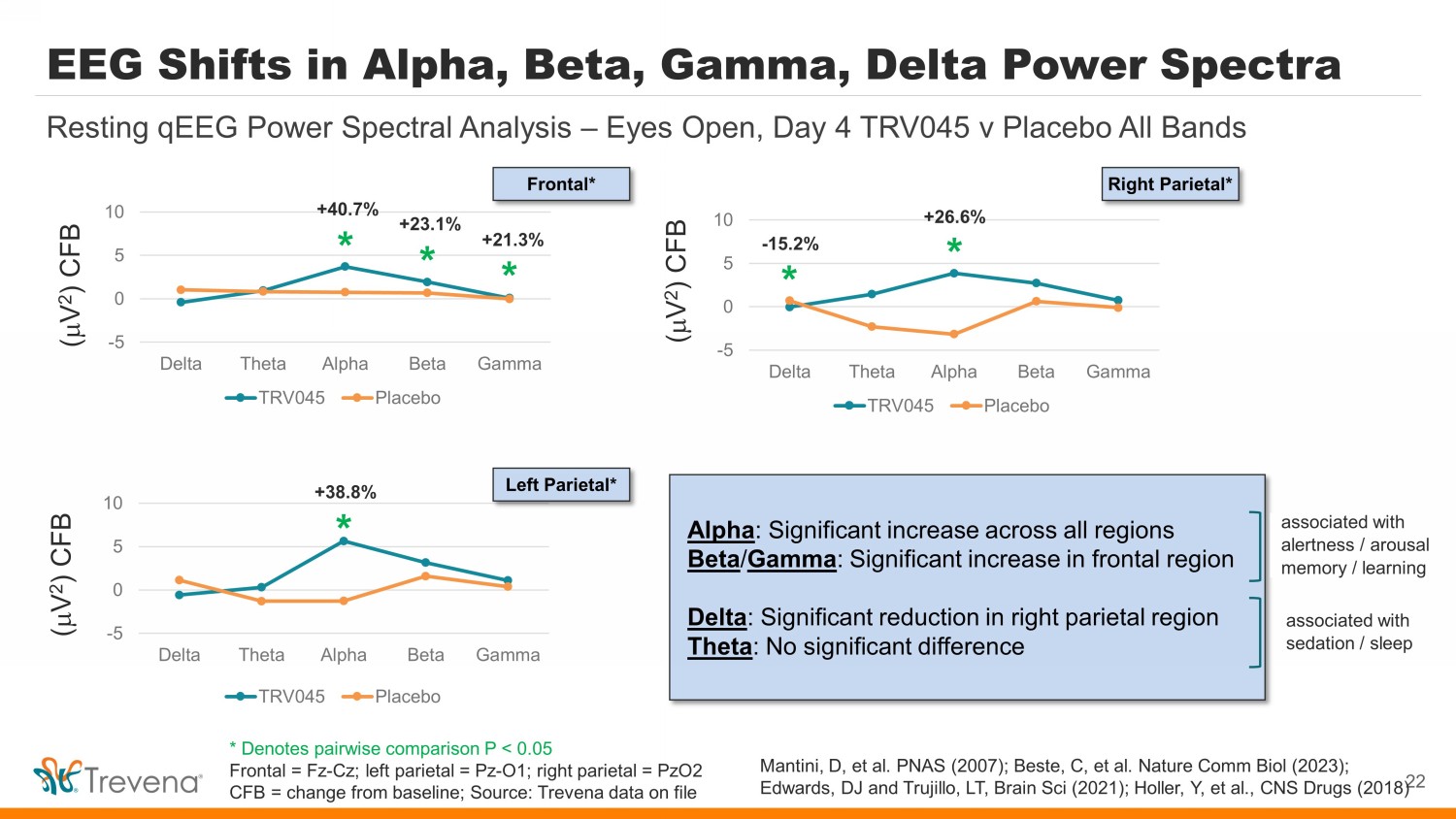
EEG Shifts in Alpha, Beta, Gamma, Delta Power Spectra -5 0 5 10 Delta Theta Alpha Beta Gamma TRV045 Placebo 22 Resting qEEG Power Spectral Analysis – Eyes Open, Day 4 TRV045 v Placebo All Bands -5 0 5 10 Delta Theta Alpha Beta Gamma TRV045 Placebo -5 0 5 10 Delta Theta Alpha Beta Gamma TRV045 Placebo * * * * * * +21.3% - 15.2% +23.1% +40.7% +38.8% +26.6% ( m V 2 ) CFB ( m V 2 ) CFB ( m V 2 ) CFB Frontal* Left Parietal* Right Parietal* Alpha : Significant increase across all regions Beta / Gamma : Significant increase in frontal region Delta : Significant reduction in right parietal region Theta : No significant difference associated with alertness / arousal memory / learning associated with sedation / s leep Mantini , D, et al. PNAS (2007); Beste , C, et al. Nature Comm Biol (2023); Edwards, DJ and Trujillo, LT, Brain Sci (2021); Holler, Y, et al., CNS Drugs (2018) * Denotes pairwise comparison P < 0.05 Frontal = Fz - Cz ; left parietal = Pz - O1; right parietal = PzO2 CFB = change from baseline; Source: Trevena data on file
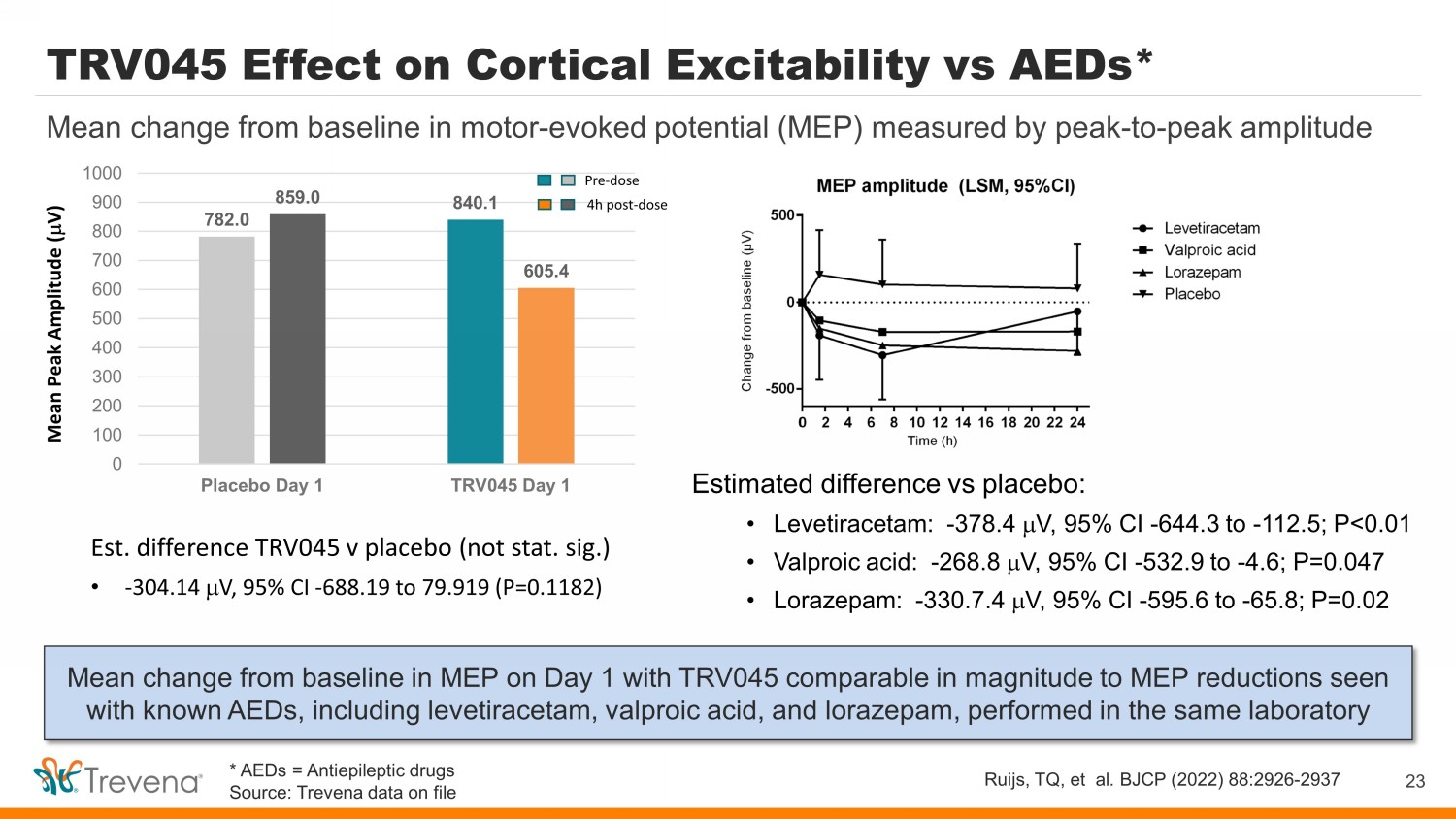
TRV045 Effect on Cortical Excitability vs AEDs* Mean change from baseline in MEP on Day 1 with TRV045 comparable in magnitude to MEP reductions seen with known AEDs, including levetiracetam, valproic acid, and lorazepam, performed in the same laboratory 23 Mean change from baseline in motor - evoked potential (MEP) measured by peak - to - peak amplitude Ruijs , TQ, et al. BJCP (2022) 88:2926 - 2937 Estimated difference vs placebo: • Levetiracetam: - 378.4 m V, 95% CI - 644.3 to - 112.5; P<0.01 • Valproic acid: - 268.8 m V, 95% CI - 532.9 to - 4.6; P=0.047 • Lorazepam: - 330.7.4 m V, 95% CI - 595.6 to - 65.8; P=0.02 782.0 840.1 859.0 605.4 0 100 200 300 400 500 600 700 800 900 1000 Placebo Day 1 TRV045 Day 1 Mean Peak Amplitude ( m V) Pre - dose 4h post - dose Est. difference TRV045 v placebo (not stat. sig.) • - 304.14 m V, 95% CI - 688.19 to 79.919 (P=0.1182) * AEDs = Antiepileptic drugs Source: Trevena data on file
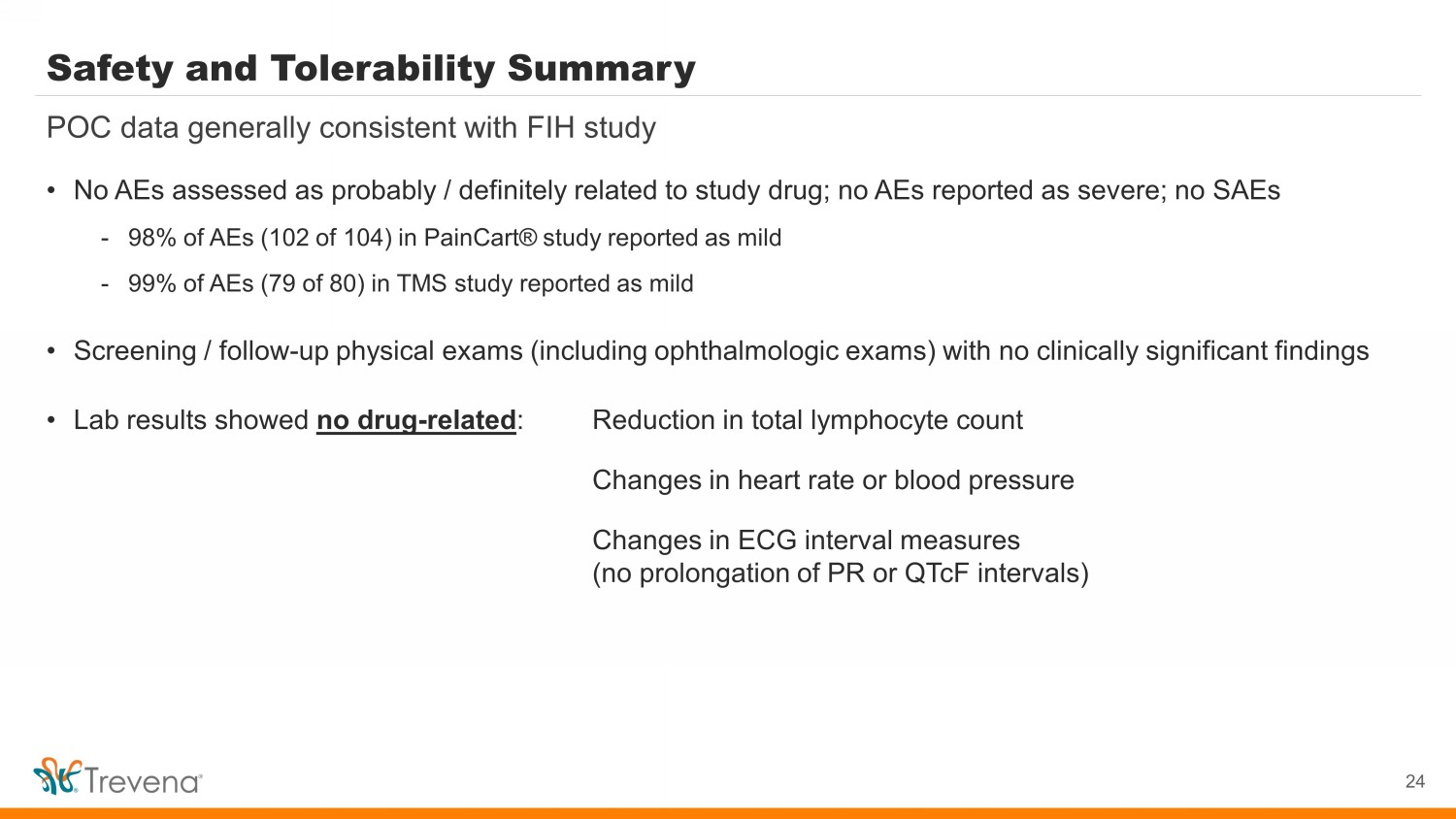
Safety and Tolerability Summary • No AEs assessed as probably / definitely related to study drug; no AEs reported as severe; no SAEs - 98% of AEs (102 of 104) in PainCart ® study reported as mild - 99% of AEs (79 of 80) in TMS study reported as mild • Screening / follow - up physical exams (including ophthalmologic exams) with no clinically significant findings • Lab results showed no drug - related : Reduction in total lymphocyte count Changes in heart rate or blood pressure Changes in ECG interval measures (no prolongation of PR or QTcF intervals) 24 POC data generally consistent with FIH study
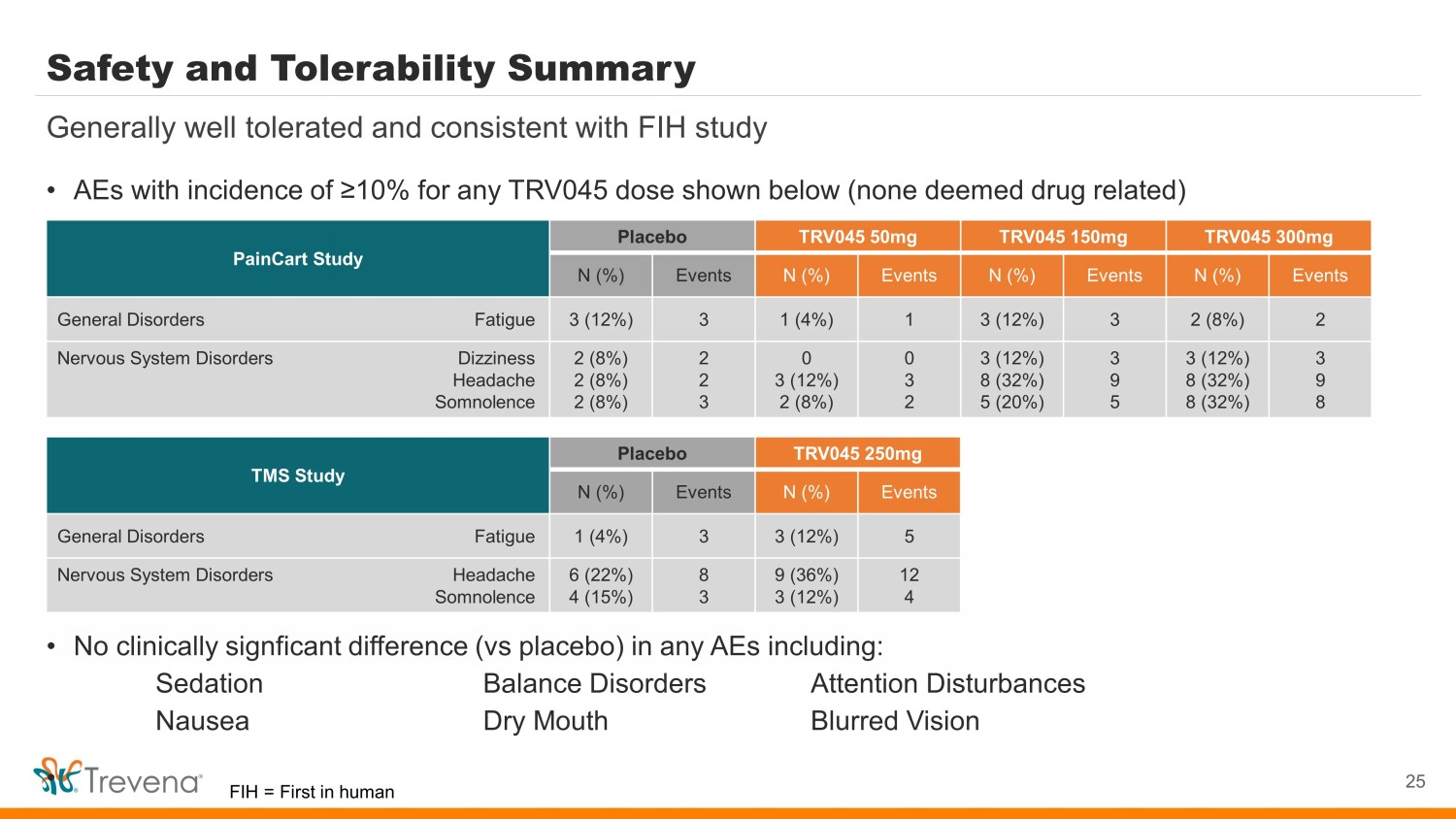
Safety and Tolerability Summary • AEs with incidence of ≥10% for any TRV045 dose shown below (none deemed drug related) • No clinically signficant difference (vs placebo) in any AEs including: Sedation Balance Disorders Attention Disturbances Nausea Dry Mouth Blurred Vision • 25 Generally well tolerated and consistent with FIH study PainCart Study Placebo TRV045 50mg TRV045 150mg TRV045 300mg N (%) Events N (%) Events N (%) Events N (%) Events General Disorders Fatigue 3 (12%) 3 1 (4%) 1 3 (12%) 3 2 (8%) 2 Nervous System Disorders Dizziness Headache Somnolence 2 (8%) 2 (8%) 2 (8%) 2 2 3 0 3 (12%) 2 (8%) 0 3 2 3 (12%) 8 (32%) 5 (20%) 3 9 5 3 (12%) 8 (32%) 8 (32%) 3 9 8 TMS Study Placebo TRV045 250mg N (%) Events N (%) Events General Disorders Fatigue 1 (4%) 3 3 (12%) 5 Nervous System Disorders Headache Somnolence 6 (22%) 4 (15%) 8 3 9 (36%) 3 (12%) 12 4 FIH = First in human
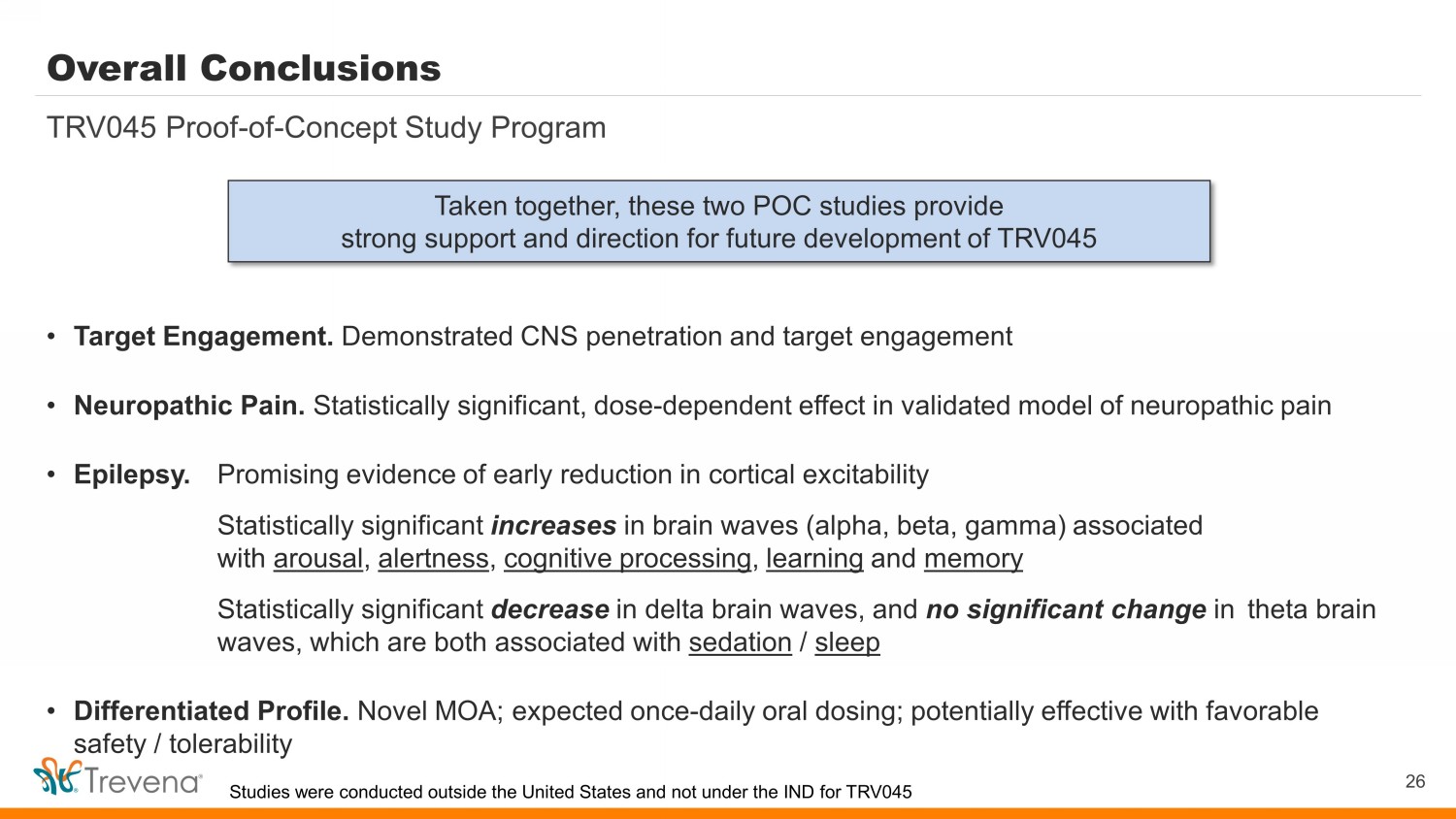
Overall Conclusions • Target Engagement. Demonstrated CNS penetration and target engagement • Neuropathic Pain. Statistically significant, dose - dependent effect in validated model of neuropathic pain • Epilepsy. Promising evidence of early reduction in cortical excitability Statistically significant increases in brain waves (alpha, beta, gamma) associated with arousal , alertness , cognitive processing , learning and memory Statistically significant decrease in delta brain waves, and no significant change in theta brain waves, which are both associated with sedation / sleep • Differentiated Profile. Novel MOA; expected once - daily oral dosing; potentially effective with favorable safety / tolerability TRV045 Proof - of - Concept Study Program Taken together, these two POC studies provide strong support and direction for future development of TRV045 Studies were conducted outside the United States and not under the IND for TRV045 26
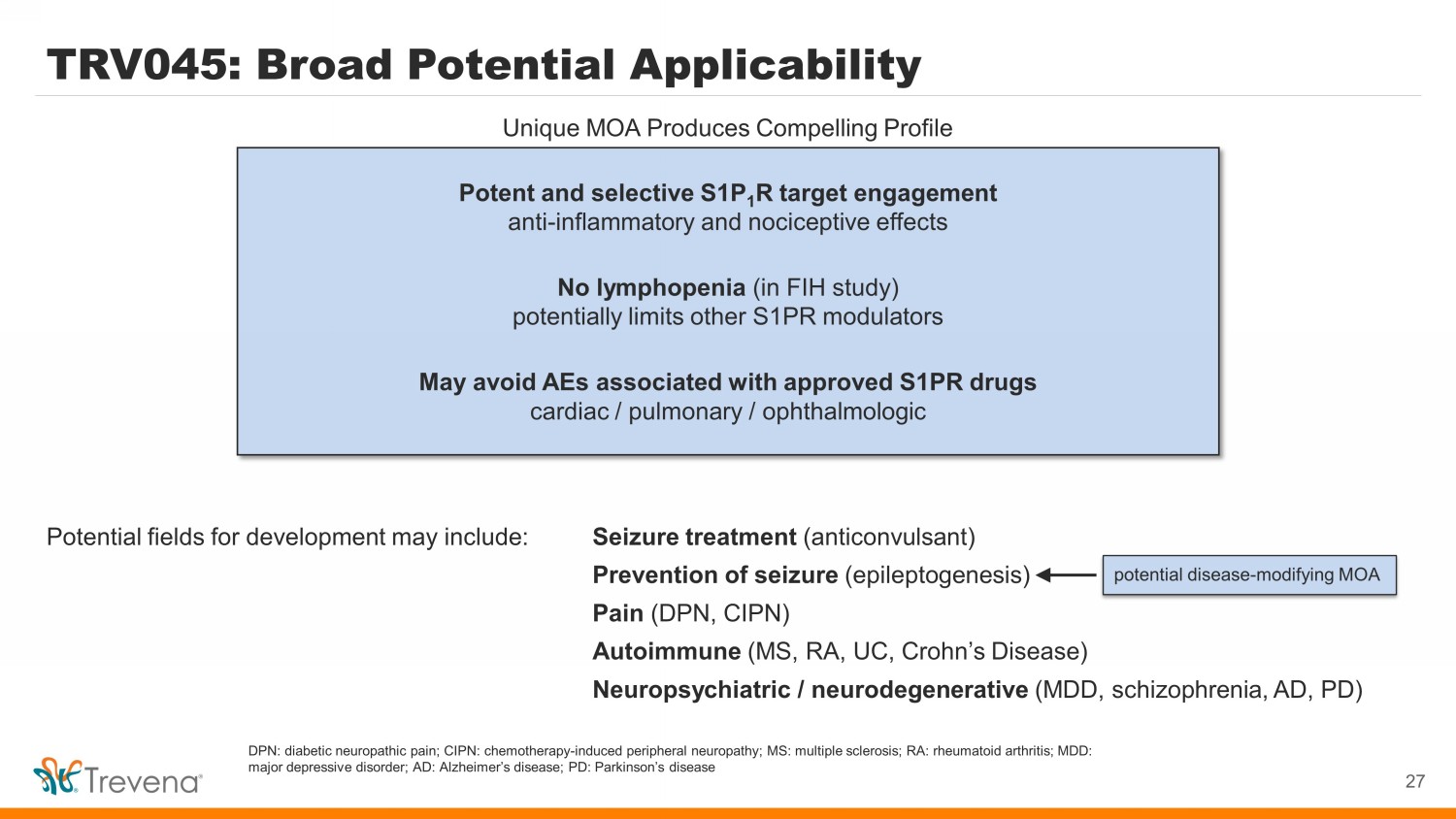
TRV045: Broad Potential Applicability Potential fields for development may include: Seizure treatment (anticonvulsant) Prevention of seizure ( epileptogenesis ) Pain (DPN, CIPN) Autoimmune (MS, RA, UC, Crohn’s Disease) Neuropsychiatric / neurodegenerative (MDD, schizophrenia, AD, PD) Potent and selective S1P 1 R target engagement anti - inflammatory and nociceptive effects No lymphopenia (in FIH study) potentially limits other S1PR modulators May avoid AEs associated with approved S1PR drugs cardiac / pulmonary / ophthalmologic 27 Unique MOA Produces Compelling Profile p otential disease - modifying MOA DPN: diabetic neuropathic pain; CIPN: chemotherapy - induced peripheral neuropathy; MS: multiple sclerosis; RA: rheumatoid arthrit is; MDD: major depressive disorder; AD: Alzheimer’s disease; PD: Parkinson’s disease
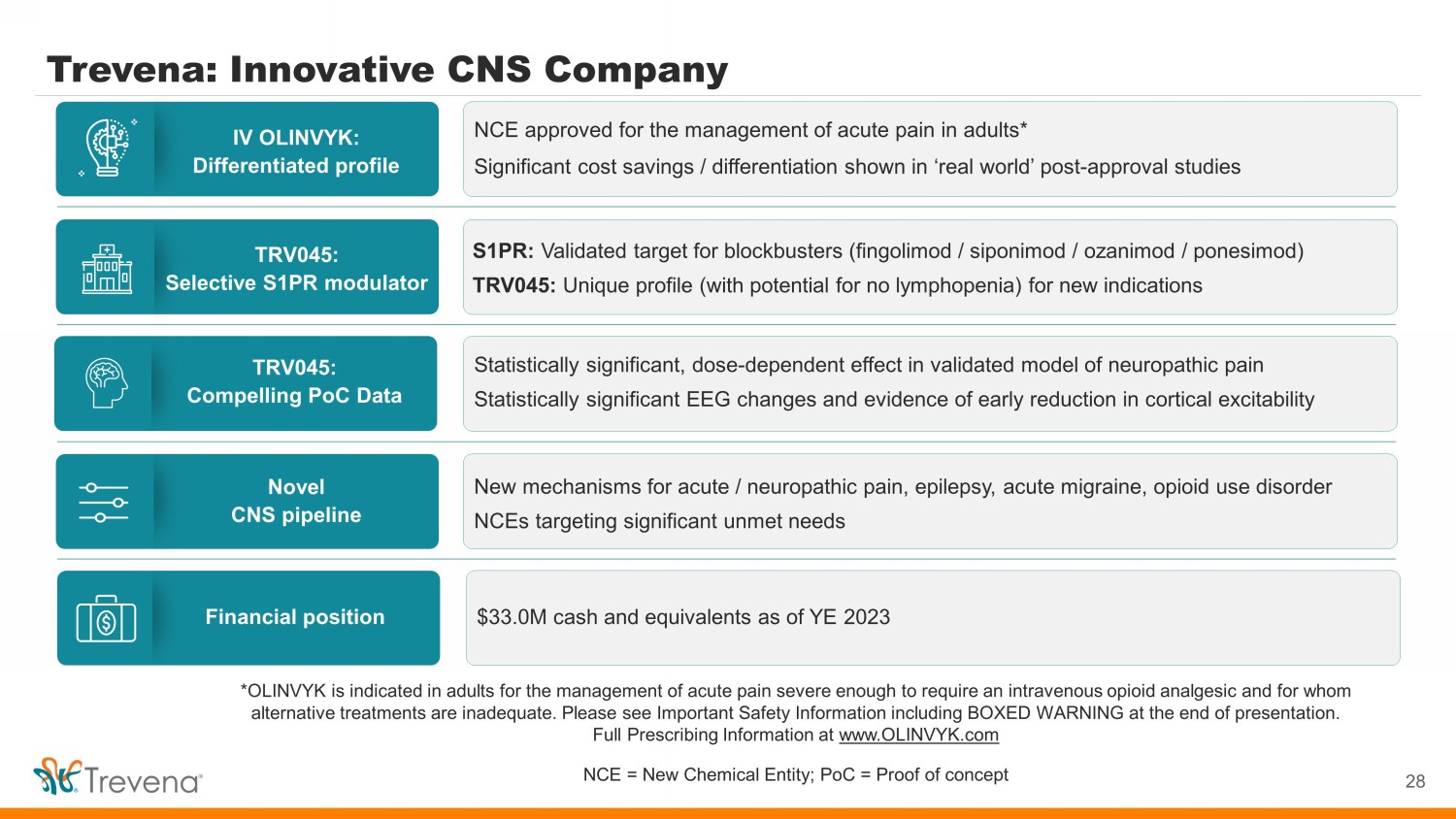
*OLINVYK is indicated in adults for the management of acute pain severe enough to require an intravenous opioid analgesic and fo r whom alternative treatments are inadequate. Please see Important Safety Information including BOXED WARNING at the end of presentation. Full Prescribing Information at www.OLINVYK.com NCE = New Chemical Entity; PoC = Proof of concept Trevena: Innovative CNS Company 28 IV OLINVYK: Differentiated profile TRV045: Selective S1PR modulator Novel CNS pipeline TRV045: Compelling PoC Data Financial position NCE approved for the management of acute pain in adults* Significant cost savings / differentiation shown in ‘real world’ post - approval studies S1PR: Validated target for blockbusters (fingolimod / siponimod / ozanimod / ponesimod ) TRV045: Unique profile (with potential for no lymphopenia) for new indications New mechanisms for acute / neuropathic pain, epilepsy, acute migraine, opioid use disorder NCEs targeting significant unmet needs Statistically significant, dose - dependent effect in validated model of neuropathic pain Statistically significant EEG changes and e vidence of early reduction in cortical excitability $33.0M cash and equivalents as of YE 2023

29 IMPORTANT SAFETY INFORMATION
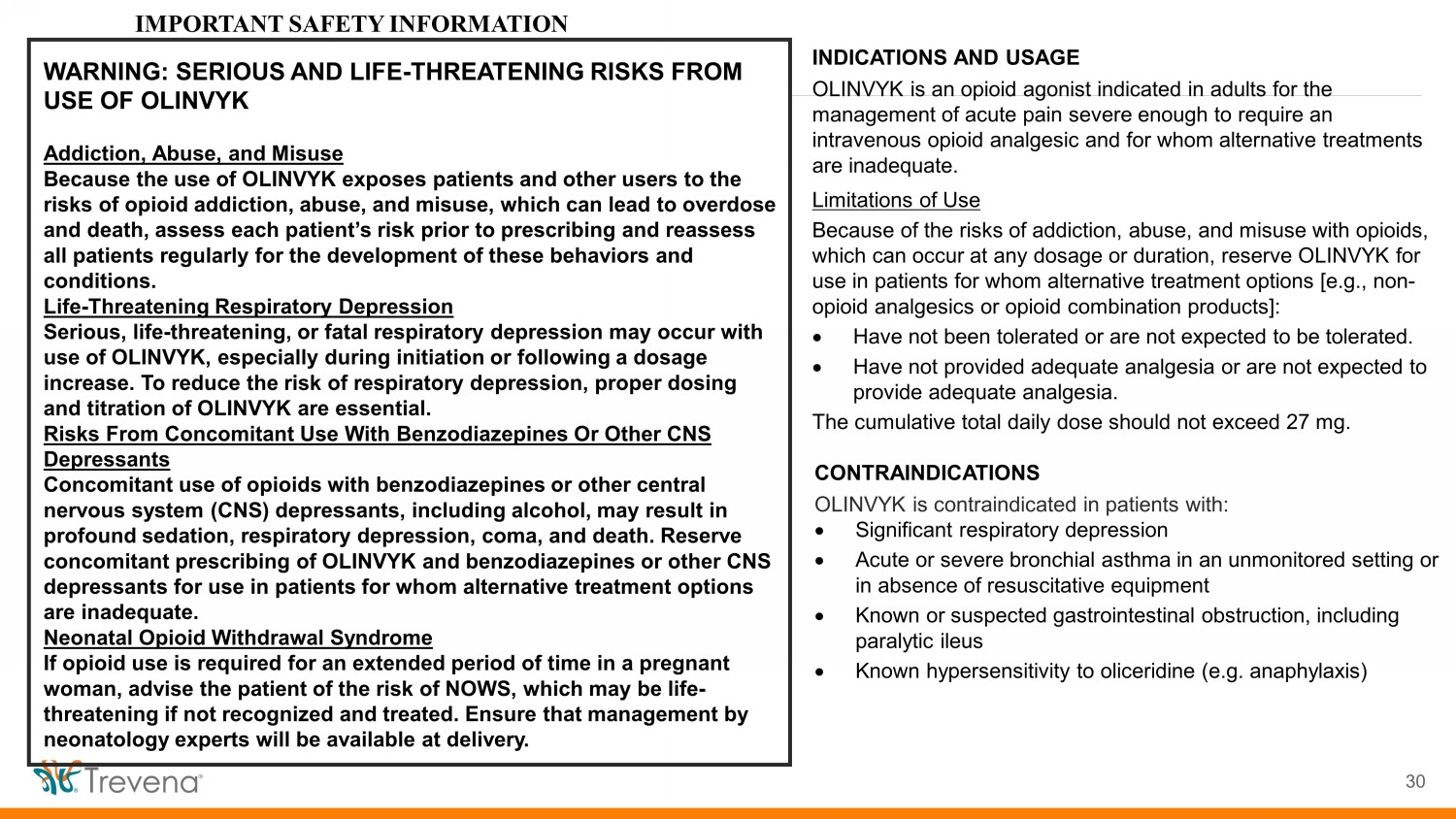
30 IMPORTANT SAFETY INFORMATION WARNING: SERIOUS AND LIFE - THREATENING RISKS FROM USE OF OLINVYK Addiction, Abuse, and Misuse Because the use of OLINVYK exposes patients and other users to the risks of opioid addiction, abuse, and misuse, which can lead to overdose and death, assess each patient’s risk prior to prescribing and reassess all patients regularly for the development of these behaviors and conditions. Life - Threatening Respiratory Depression Serious, life - threatening, or fatal respiratory depression may occur with use of OLINVYK, especially during initiation or following a dosage increase. To reduce the risk of respiratory depression, proper dosing and titration of OLINVYK are essential. Risks From Concomitant Use With Benzodiazepines Or Other CNS Depressants Concomitant use of opioids with benzodiazepines or other central nervous system (CNS) depressants, including alcohol, may result in profound sedation, respiratory depression, coma, and death. Reserve concomitant prescribing of OLINVYK and benzodiazepines or other CNS depressants for use in patients for whom alternative treatment options are inadequate. Neonatal Opioid Withdrawal Syndrome If opioid use is required for an extended period of time in a pregnant woman, advise the patient of the risk of NOWS, which may be life - threatening if not recognized and treated. Ensure that management by neonatology experts will be available at delivery. INDICATIONS AND USAGE OLINVYK is an opioid agonist indicated in adults for the management of acute pain severe enough to require an intravenous opioid analgesic and for whom alternative treatments are inadequate. Limitations of Use Because of the risks of addiction, abuse, and misuse with opioids, which can occur at any dosage or duration, reserve OLINVYK for use in patients for whom alternative treatment options [e.g., non - opioid analgesics or opioid combination products]: Have not been tolerated or are not expected to be tolerated. Have not provided adequate analgesia or are not expected to provide adequate analgesia. The cumulative total daily dose should not exceed 27 mg. CONTRAINDICATIONS OLINVYK is contraindicated in patients with: Significant respiratory depression Acute or severe bronchial asthma in an unmonitored setting or in absence of resuscitative equipment Known or suspected gastrointestinal obstruction, including paralytic ileus Known hypersensitivity to oliceridine (e.g. anaphylaxis)
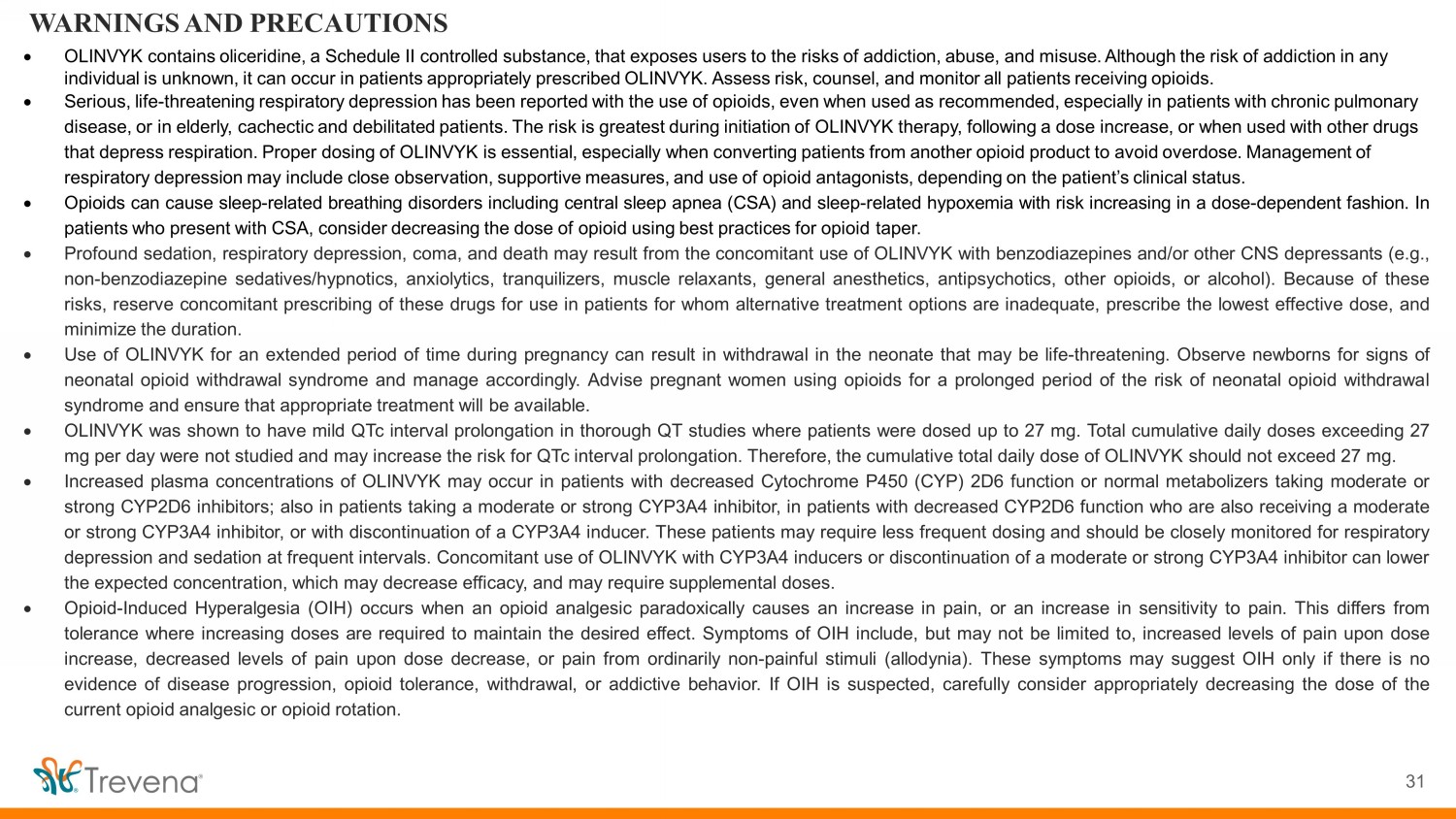
31 WARNINGS AND PRECAUTIONS OLINVYK contains oliceridine, a Schedule II controlled substance, that exposes users to the risks of addiction, abuse, and misuse. Although the risk of addiction in any individual is unknown, it can occur in patients appropriately prescribed OLINVYK. Assess risk, counsel, and monitor all patients receiving opioids. Serious, life - threatening respiratory depression has been reported with the use of opioids, even when used as recommended, especially in patients with chronic pulmonary disease, or in elderly, cachectic and debilitated patients. The risk is greatest during initiation of OLINVYK therapy, following a dose increase, or when used with other drugs that depress respiration. Proper dosing of OLINVYK is essential, especially when converting patients from another opioid product to avoid overdose. Management of respiratory depression may include close observation, supportive measures, and use of opioid antagonists, depending on the patient’s clinical status. Opioids can cause sleep - related breathing disorders including central sleep apnea (CSA) and sleep - related hypoxemia with risk increasing in a dose - dependent fashion . In patients who present with CSA, consider decreasing the dose of opioid using best practices for opioid taper . Profound sedation, respiratory depression, coma, and death may result from the concomitant use of OLINVYK with benzodiazepines and/or other CNS depressants (e . g . , non - benzodiazepine sedatives/hypnotics, anxiolytics, tranquilizers, muscle relaxants, general anesthetics, antipsychotics, other opioids, or alcohol) . Because of these risks, reserve concomitant prescribing of these drugs for use in patients for whom alternative treatment options are inadequate, prescribe the lowest effective dose, and minimize the duration . Use of OLINVYK for an extended period of time during pregnancy can result in withdrawal in the neonate that may be life - threatening . Observe newborns for signs of neonatal opioid withdrawal syndrome and manage accordingly . Advise pregnant women using opioids for a prolonged period of the risk of neonatal opioid withdrawal syndrome and ensure that appropriate treatment will be available . OLINVYK was shown to have mild QTc interval prolongation in thorough QT studies where patients were dosed up to 27 mg . Total cumulative daily doses exceeding 27 mg per day were not studied and may increase the risk for QTc interval prolongation . Therefore, the cumulative total daily dose of OLINVYK should not exceed 27 mg . Increased plasma concentrations of OLINVYK may occur in patients with decreased Cytochrome P 450 (CYP) 2 D 6 function or normal metabolizers taking moderate or strong CYP 2 D 6 inhibitors ; also in patients taking a moderate or strong CYP 3 A 4 inhibitor, in patients with decreased CYP 2 D 6 function who are also receiving a moderate or strong CYP 3 A 4 inhibitor, or with discontinuation of a CYP 3 A 4 inducer . These patients may require less frequent dosing and should be closely monitored for respiratory depression and sedation at frequent intervals . Concomitant use of OLINVYK with CYP 3 A 4 inducers or discontinuation of a moderate or strong CYP 3 A 4 inhibitor can lower the expected concentration, which may decrease efficacy, and may require supplemental doses . Opioid - Induced Hyperalgesia (OIH) occurs when an opioid analgesic paradoxically causes an increase in pain, or an increase in sensitivity to pain . This differs from tolerance where increasing doses are required to maintain the desired effect . Symptoms of OIH include, but may not be limited to, increased levels of pain upon dose increase, decreased levels of pain upon dose decrease, or pain from ordinarily non - painful stimuli (allodynia) . These symptoms may suggest OIH only if there is no evidence of disease progression, opioid tolerance, withdrawal, or addictive behavior . If OIH is suspected, carefully consider appropriately decreasing the dose of the current opioid analgesic or opioid rotation .
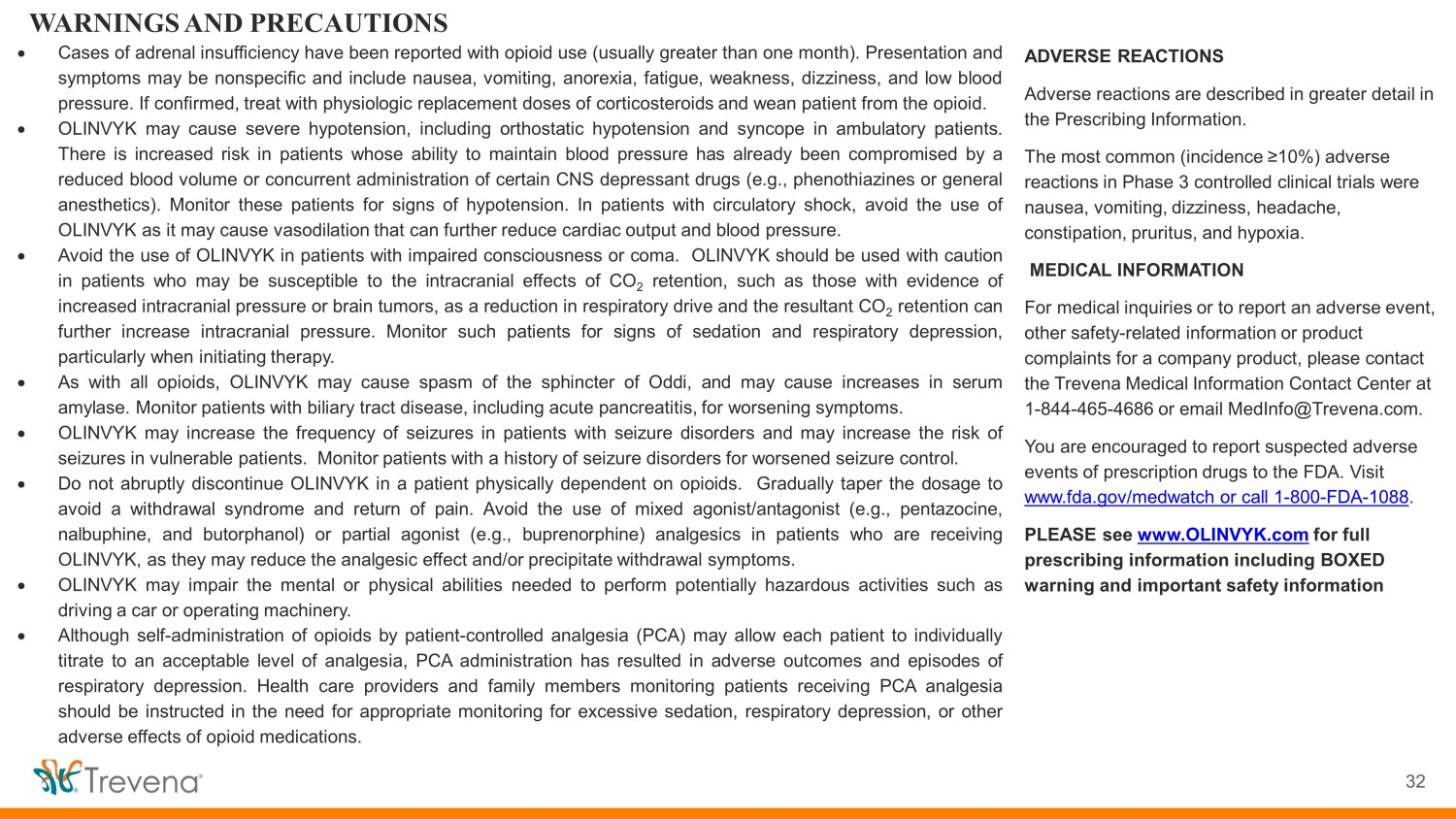
32 WARNINGS AND PRECAUTIONS Cases of adrenal insufficiency have been reported with opioid use (usually greater than one month) . Presentation and symptoms may be nonspecific and include nausea, vomiting, anorexia, fatigue, weakness, dizziness, and low blood pressure . If confirmed, treat with physiologic replacement doses of corticosteroids and wean patient from the opioid . OLINVYK may cause severe hypotension, including orthostatic hypotension and syncope in ambulatory patients . There is increased risk in patients whose ability to maintain blood pressure has already been compromised by a reduced blood volume or concurrent administration of certain CNS depressant drugs (e . g . , phenothiazines or general anesthetics) . Monitor these patients for signs of hypotension . In patients with circulatory shock, avoid the use of OLINVYK as it may cause vasodilation that can further reduce cardiac output and blood pressure . Avoid the use of OLINVYK in patients with impaired consciousness or coma . OLINVYK should be used with caution in patients who may be susceptible to the intracranial effects of CO 2 retention, such as those with evidence of increased intracranial pressure or brain tumors, as a reduction in respiratory drive and the resultant CO 2 retention can further increase intracranial pressure . Monitor such patients for signs of sedation and respiratory depression, particularly when initiating therapy . As with all opioids, OLINVYK may cause spasm of the sphincter of Oddi, and may cause increases in serum amylase . Monitor patients with biliary tract disease, including acute pancreatitis, for worsening symptoms . OLINVYK may increase the frequency of seizures in patients with seizure disorders and may increase the risk of seizures in vulnerable patients . Monitor patients with a history of seizure disorders for worsened seizure control . Do not abruptly discontinue OLINVYK in a patient physically dependent on opioids . Gradually taper the dosage to avoid a withdrawal syndrome and return of pain . Avoid the use of mixed agonist/antagonist (e . g . , pentazocine, nalbuphine, and butorphanol) or partial agonist (e . g . , buprenorphine) analgesics in patients who are receiving OLINVYK, as they may reduce the analgesic effect and/or precipitate withdrawal symptoms . OLINVYK may impair the mental or physical abilities needed to perform potentially hazardous activities such as driving a car or operating machinery . Although self - administration of opioids by patient - controlled analgesia (PCA) may allow each patient to individually titrate to an acceptable level of analgesia, PCA administration has resulted in adverse outcomes and episodes of respiratory depression . Health care providers and family members monitoring patients receiving PCA analgesia should be instructed in the need for appropriate monitoring for excessive sedation, respiratory depression, or other adverse effects of opioid medications . ADVERSE REACTIONS Adverse reactions are described in greater detail in the Prescribing Information. The most common (incidence ≥10%) adverse reactions in Phase 3 controlled clinical trials were nausea, vomiting, dizziness, headache, constipation, pruritus, and hypoxia. MEDICAL INFORMATION For medical inquiries or to report an adverse event, other safety - related information or product complaints for a company product, please contact the Trevena Medical Information Contact Center at 1 - 844 - 465 - 4686 or email MedInfo@Trevena.com. You are encouraged to report suspected adverse events of prescription drugs to the FDA. Visit www.fda.gov/medwatch or call 1 - 800 - FDA - 1088 . PLEASE see www.OLINVYK.com for full prescribing information including BOXED warning and important safety information